












Neal Auction is delighted to present our second annual auction dedicated to women artists. Celebrating work by women, this auction presents a thoughtfully curated selection of lots with unique perspectives from both well-established names and gifted emerging creators from the American South and beyond.
The art world’s upward trend for women artists can be seen across all levels of the market, with enthusiasm for those currently working and a renewed interest in artists from the past. In keeping with the growing focus on this category of collecting, this auction pays homage to the female eye while encouraging new dialogue and generating heightened appreciation for each artist featured in the sale.
All lots are available for preview beginning Thursday, May 23 at our New Orleans Magazine Street gallery.



Through Her Eyes: Women in Art Auction begins at 2:00 PM CST on May 30, 2024 on all three bidding platforms.



1. Elizabeth Nelson Fairchild (American/New York, b. 1910), “Tavern Scene”, oil on canvas, signed lower left, handwritten label with artist on stretcher, inscribed “Estate of Artist” on backing paper, 20 in. x 26 in., framed, overall 24 1/8 in. x 30 1/8 in. x 1 in.
[$600/800]
Note: Elizabeth Nelson Fairchild was born in Yonkers, New York. She studied at the Arts Students League of New York under Frank Vincent Dumond and was a member of the Catherine Lorillard Wolfe Art Club, a national organization founded in 1896 to show and promote works by professional women artists. Fairchild exhibited at the Allied Artists of America in 1945 and other locations nationally. She was active in New York and California, seeing success both as a painter and illustrator. Her work includes genre and hunting scenes and portraits.
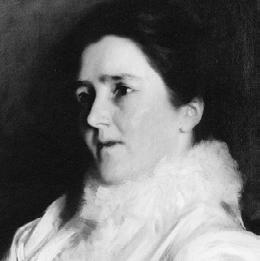
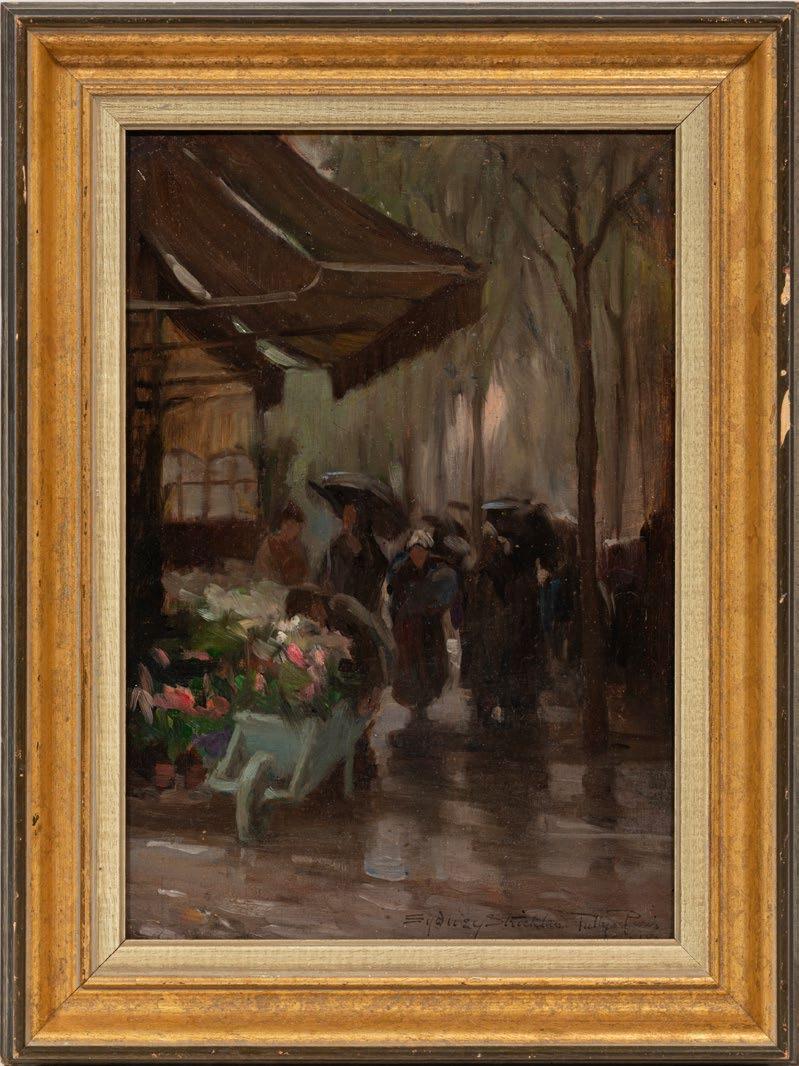
3. Ruth Payne Burgess (American/Vermont, 1865-1934),
“Blue and White Jar”, oil on canvas, signed, titled and “E. & A. Milch, New York City, NY” label on stretcher, 20 1/4 in. x 16 1/4 in., framed, overall 26 1/2 in. x 22 1/2 in. x 1 1/2 in.
[$1200/1800]
Note: Ruth Payne Burgess was born in Montpelier, Vermont. She attended the Mary A. Burnham School in Northampton, Massachusetts before studying at the Art Students League of New York as well as in Germany and Italy. In 1885, she married John William Burgess, founder of the political science department at Columbia University. After opening an art studio in New York, Burgess became known for her works in oil and watercolor with portraiture, still lifes and landscapes her preferred subjects. Her work was included in nine exhibitions at the National Academy of Design from 1897 to 1906 as well as from 1924 to 1933. In 1899, Burgess joined the National Association of Women Artists and the Woman’s Art Club of New York, where she served as the president from 1905 to 1910.

2. Sydney Strickland Tully (Canadian, 1860-1911),
“Paris”, 1907, oil on panel, signed, titled and dated lower right, “Uno Langmann Limited, Vancouver, Canada” label with artist and title on reverse of frame, exhibition information en verso, 13 in. x 9 in., framed, overall 16 3/8 in. x 12 1/2 in. x 1 1/2 in.
[$400/600]
Note: Sydney Strickland Tully was born in Toronto in 1860. She studied at the Central Ontario School of Art, Slade School of Art and the Académie Julian as well as with the artist William Merritt Chase at the Long Island Art School. She was an associate of the Royal Canadian Academy of Arts as well as an elected member of the Ontario Society of Artists, and she regularly exhibited her works with both organizations. Tully was known for her landscapes, genre scenes and portraits.


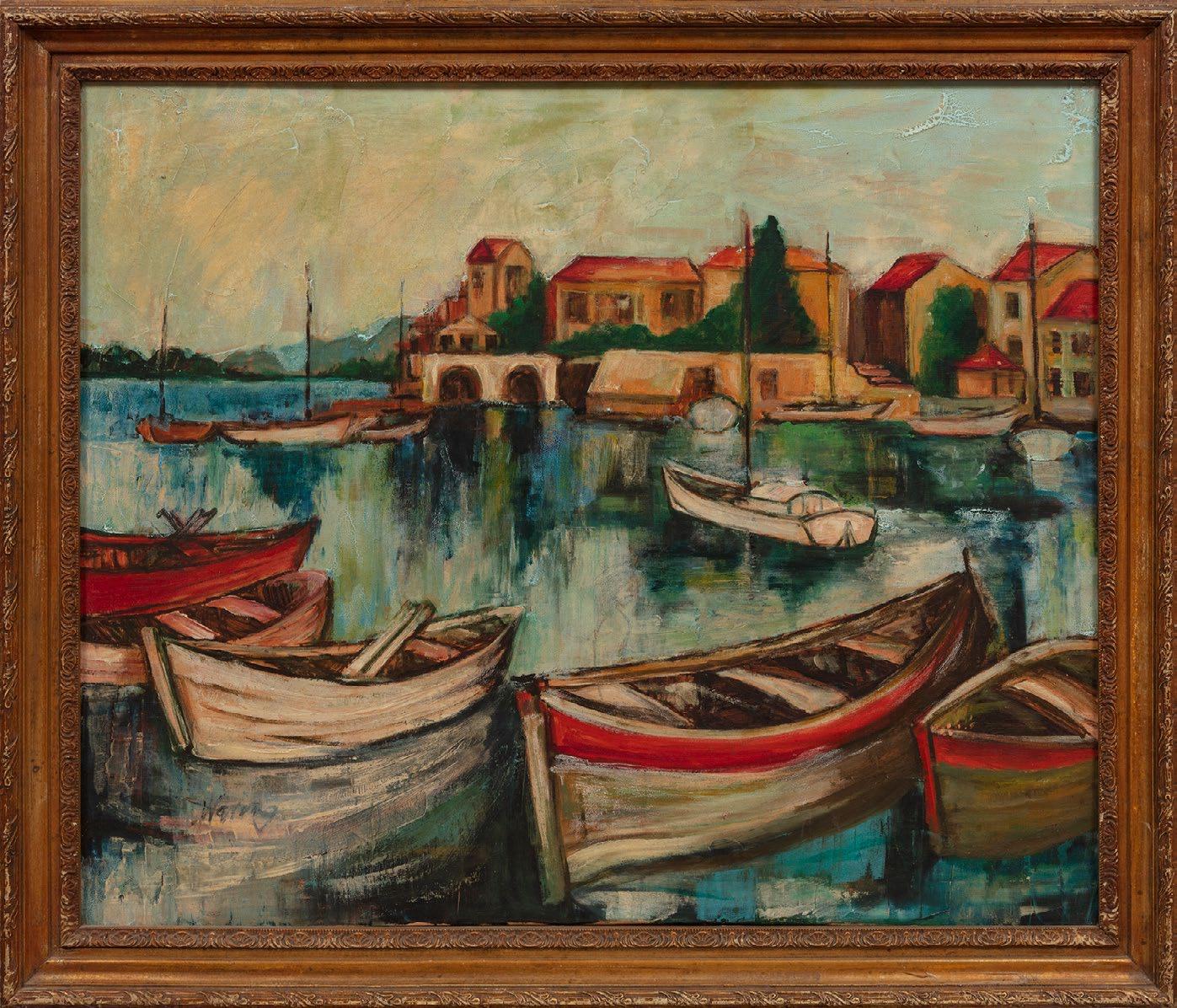
4. Laura Wheeler Waring (American/Pennsylvania, 1887-1948), “St. Jean”, oil on canvas, signed lower left, titled on stretcher, inscribed en verso, 30 in. x 36 in., framed, overall 35 in. x 41 in. x 2 1/8 in. [$5000/8000]
Note: Laura Wheeler Waring was born in 1887 in Hartford, Connecticut to a pastor father and a teacher and amateur artist mother. After demonstrating artistic promise in school, she attended the prestigious Pennsylvania Academy of Fine Arts. When she graduated in 1914, she received the A. William Emlen Cresson Memorial Travel Scholarship which led her to studying in Paris. This trip and subsequent visits to Paris greatly influenced her work. After returning to the United States, Wheeler Waring became a teacher at Cheyney Training School for Teachers, an all-Black school in Philadelphia where she established and chaired the art and music departments. In 1928 the Harmon Foundation put together a showcase of prominent artists of the Harlem Renaissance which featured Laura Wheeler Waring’s work. Following this exhibition, the Harmon Foundation requested her to complete several more portraits to include in their 1944 traveling exhibition which featured portraits of contemporary African Americans and their accomplishments. The success of the exhibition led to Laura Wheeler Waring becoming well known for her portraiture. Wheeler Waring died in her Philadelphia home in 1948, and several of her portraits are on display at the Smithsonian National Portrait Gallery.
Ref.: “Laura Wheeler Waring.” Connecticut Women’s Hall of Fame. www.cwhf.org Accessed May 2, 2024.



5. Charlotte Buell Coman (American/New York, 1833-1924), “New Jersey Hills in Autumn from Cedar Crest Farm”, oil on canvas, signed lower left, titled en verso and along upper tacking edge, 16 in. x 19 in., framed, overall 20 1/4 in. x 23 3/8 in. x 2 in.
[$1000/1500]
Note: Charlotte Coman started painting in her mid-forties after experiencing hearing loss and becoming almost entirely deaf. She studied in New York and Paris and was greatly influenced by the Barbizon school of painting. She adopted the style in her own landscapes and was one of several noted artists who brought Barbizon techniques to the United States. Good humored, Coman once joked that one of the advantages of hearing loss was that she was spared harsh criticism from art critics who shied away from shouting their opinions into her ear trumpet. Over time, her artwork evolved, and she became known for her tonalist quality and hazy, blue-toned landscapes. Her artwork can be found in the collections of the Arnot Art Museum and the Metropolitan Museum of Art. Ref.: Rubenstein, Charlotte Streifer. American Women Artists: From Early Indian Times to the Present. Boston: Avon Books, 1982, pp. 58-59.

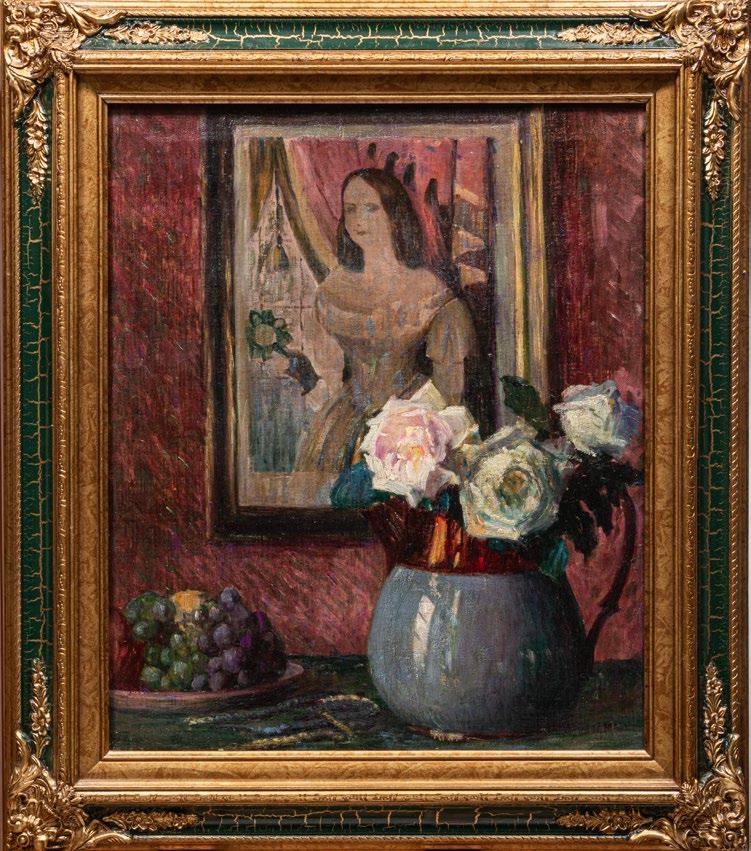
6. Mary Alexandra Bell Eastlake (Canadian, 1864-1951), “Lucile Gossage (1902-1992)”, pastel on paper, signed lower right, titled upper left, “The Pastel Society Royal Institute Galleries, Picadilly, London” exhibition label with artist and title and handwritten label with sitter on backing board, 14 1/2 in. x 12 in., framed, overall 15 7/8 in. x 13 1/2 in. x 1 in.
[$400/600]
Note: Canadian artist Mary Alexandra Bell Eastlake was best known for her portraits of women and children as well as her jewelry designs. She studied with Robert Harris at the Art Association of Montreal, under William Merritt Chase at the Art Students League of New York, and at the Académie Julian in Paris. She exhibited in the Paris Salon in 1889 and 1906 and was elected an associate of the Royal Canadian Academy of Arts in 1893. After meeting Charles Herbert Eastlake, an English painter and director of the Chelsea Polytechnic, and marrying him in 1897, Eastlake moved to England and devoted time to learning enamel and metal work to produce jewelry as an applied art. She returned to Canada following the death of her husband in 1939. In addition to the Salon, Eastlake exhibited at the Royal Academy, New English Art Club and throughout the United States and Canada.
7. Maud Mary Mason (American/Connecticut, 1867-1956), “Still Life, The Lustre Pitcher”, oil on canvas, signed lower right, “The National Arts Club, New York, NY” label with artist, handwritten label with title and artist information on backing board, 24 1/8 in. x 20 1/4 in., framed, overall 31 1/2 in. x 27 1/2 in. x 2 1/2 in.
[$800/1200]
Note: Maud Mason was born in rural Kentucky and likely began decorating “china blanks” with her two sisters during her teenage years to supplement the family’s income, inspiring a lifetime of artistic pursuit. After working as a china decorator in Toronto, Mason moved to New York by 1895 and took classes at the Art Students League with William Merritt Chase and Arthur Wesley Dow, both of whom she credited with inspiring her interest in still life and her strong foundation in color and composition. Mason later became a teacher herself and a leader in the arts community, inspiring many other professional women artists of the time. She divided her time between teaching design, ceramics and painting. An associate member of the National Academy of Design, Mason regularly participated in its annual exhibitions from 1914 to 1950. She was also a member of the National Arts Club, the Society of Ceramic Artists, and the National Association of Women Painters and Sculptors, where she served as president from 1912 to 1917.
Ref.: “Mason, Maud (1967-1956).” The Johnson Collection. www.thejohnsoncollection.org. Accessed May 6, 2024.



8. Mabel May Woodward (American/Rhode Island, 1877-1945), “Iris”, oil on canvas laid on board, signed lower right, 10 3/4 in. x 7 5/8 in., framed, overall 17 3/8 in. x 14 1/8 in. x 2 1/2 in.
[$400/600]
Note: American Impressionist painter Mabel May Woodward was born in Providence, Rhode Island. She received her early art training at the Rhode Island School of Design and continued her studies at the Art Students League of New York with William Merritt Chase, George Bridgman, Arthur Wesley Dow and Kenyon Cox. She attended Charles Herbert Woodbury’s Ogunquit Summer School of Drawing and Painting in Maine and later worked with Frank DuMond in Old Lyme, Connecticut. Woodward won a gold medal at the Art Institute of Chicago in 1908 and was widely exhibited nationally. She also was a faculty member of the Rhode Island School of Design for twenty-five years, where she developed the “Action Class,” a pioneering concept to study the human figure as a machine rather than a stationary object. Woodward’s subjects included genre scenes, European villages, farms, still lifes, flowers and the airy New England coastal scenes for which she is best known.
Ref.: “Mabel Woodward 1877-1945.” William Vareika Fine Arts Ltd. www.vareikafinearts.com. Accessed May 1, 2024.
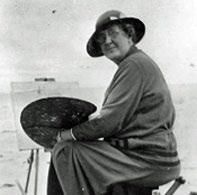
9. Pauline Palmer (American, 1867-1938), “Portrait of a Baby”, oil on canvas, signed lower right, 12 1/4 in. x 10 3/8 in., framed, overall 15 3/4 in. x 13 5/8 in. x 1 1/2 in.
[$800/1200]
Note: Known as “Chicago’s Painter Lady,” Pauline Palmer was arguably the bestknown woman artist of her time in the city. She was born in McHenry, IL and attended school in Milwaukee before teaching art in Chicago’s public schools. Her marriage in 1891 to a prosperous physician enabled her to undertake a fulltime career as an artist. Palmer studied at the Art Institute of Chicago and spent three years attending art academies in Paris. Upon her return to Chicago in 1902, Palmer opened a portrait studio and became an integral part of the city’s art scene. She exhibited regularly at the Art Institute’s three annual exhibitions and in important national and international exhibitions, including the Paris Salon. Her first solo show was held at the Art Institute in 1913. A leader among local artists, she was the first woman to serve as president of the Chicago Society of Artists between 1918 and 1921, and she led the Association of Chicago Painters and Sculptors from 1929 to 1931. Beginning in 1915, Palmer spent her summers in Provincetown, Massachusetts, a popular seasonal colony for both traditional and modernist painters. In addition to portraits, she painted numerous studies of women and children as well as landscapes.
Ref.: “Pauline Palmer (1867-1938).” M. Christine Schwartz Collection. www.schwartzcollection.com. Accessed May 6, 2024.


10. Marie Madeleine Seebold Molinary (American/Louisiana, 1866-1948), “Flowers”, oil on canvas, signed lower left, “Art Association of New Orleans” remnant label with artist and title on stretcher, 22 1/8 in. x 17 in., framed, overall 25 1/4 in. x 20 7/8 in. x 1 in. [$2000/3000]

Note: Marie Madeleine Seebold Molinary was a pioneer woman artist in New Orleans and the second female member of the Artists’ Association of New Orleans, to which William and Ellsworth Woodward also belonged. Daughter of the prominent New Orleans art dealer W.E. Seebold, she was introduced to the arts at a young age and was encouraged to pursue a career as an artist. Seebold studied with William Merritt Chase in New York City, at the School of the Art Institute of Chicago, and locally in New Orleans with Paul Poincy, George David Coulon and Andres Molinary. She maintained a long-term relationship with Molinary and married him on his deathbed in 1915. A talented painter, Seebold became particularly well known for her compelling still life paintings of fruit and flowers.
Ref.: Dobie, Ann B. «Marie Seebold.» 64 Parishes Sept. 12, 2012. www.64parishes.org. Accessed May 7, 2024.

11. Marie de Hoa LeBlanc (American/Louisiana, 1874-1954, active Newcomb College, 1895-1914), “View of New Orleans from Algiers Point”, oil on canvas, signed lower left, inscribed with artist and title on reverse of frame, 20 in. x 30 in., framed, overall 26 in. x 36 in. x 1 5/8 in. [$10000/15000]
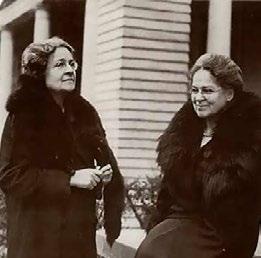
Note: Emilie and Marie de Hoa LeBlanc were two of five children born to Charles Emile LeBlanc and Elizabeth Eulalie de Hoa. Emilie was the older of the two, born in New Orleans in 1870, and Marie was born four years later. The family lived at 1225 Chartres Street, where the sisters remained after the death of their parents in 1920 until they moved to a home on Coliseum Street in 1930. The pair remained extremely close, and they lived, worked and traveled together until Emilie’s death in 1941.
Both women attended Newcomb College which would mark the beginning of their long and flourishing relationship with the institution. As some of the earliest pioneering students, their works were included in the first public exhibition of Newcomb’s decorated pottery in 1896. Later, they became paid instructors where they influenced a generation of young female artists.
The pair were well-recognized in their field – with the Museum of Fine Arts Boston acquiring one of Emilie’s oak leaf design vases as early as 1899 after exhibiting a selection of ten Newcomb pots, and Marie winning the bronze medal at the 1904 Louisiana Purchase Exposition in St. Louis for one of her designs. The sisters’ skill stands out even among the group of talented women at Newcomb Pottery, and they became two of the most accomplished and prolific decorators during the early years of production. Their vibrant paintings and surviving sketches serve to further highlight their artistic gifts and creativity.
Ref.: Conradsen, David, Ellen Paul Denker, et al. The Arts & Crafts of Newcomb Pottery. New York: Skira Rizzoli, 2013; Poeche, Jessie. Newcomb Pottery: An Enterprise for Southern Women, 1895-1940. Atglen: Schiffer Publishing, 1984; Spinozzi, Adrienne. “Marie de Hoa LeBlanc and Early Newcomb Designs.” Journal of Antiques & Collectibles. www.journalofantiques.com. Accessed May 2, 2024.

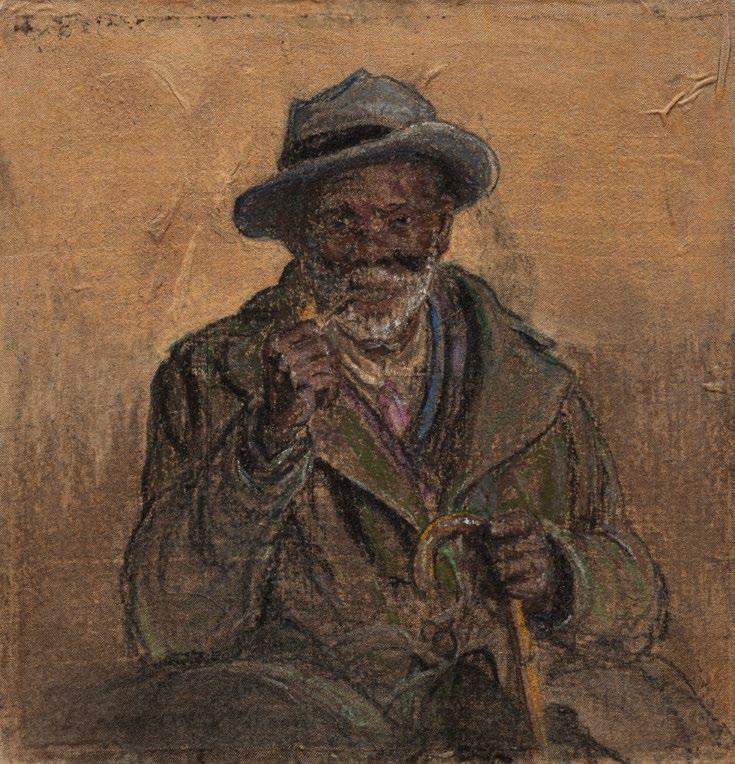
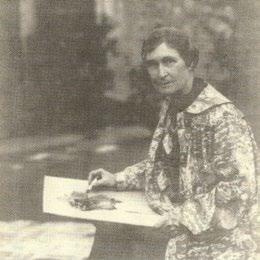
12. Geraldine Reed Millet (French/New York, 1853-1945), “Robe Rouge”, 1910, oil on canvas, signed and dated lower right, handwritten period label with title on stretcher, 25 in. x 21 1/4 in., framed, overall 28 3/8 in. x 24 1/4 in. x 1 7/8 in. [$600/800]
Note: Geraldine Millet was an American artist who spent a significant amount of time studying in France. She took classes with instructors such as Carolus Duran and Alfred Stevens. She married Francois Millet, brother of famed painter Jean-Francois Millet, and they resided in the French commune of Barbizon together.
13. Elizabeth O’Neill Verner (American/South Carolina, 1883-1979), “Portrait of a Man with Cane and Pipe”, pastel on silk laid on board, faintly signed lower left, 9 1/16 in. x 8 11/16 in., unframed. [$3000/5000]
Note: Charleston native Elizabeth O’Neill Verner was one of South Carolina’s most prominent artists of the early twentieth century – a matriarch of the Charleston Renaissance. Working primarily in pastel and printmaking, she depicted the architecture, street scenes and citizens of her hometown. Verner received early art training from Alice Ravenel Huger Smith followed by a stint at the Pennsylvania Academy of the Fine Arts in Philadelphia. In 1907, she married and had two children, with art-making a pursuit occupying only her spare time for many years. In 1923, she opened a printmaking studio and produced images of Charleston and its environs. Upon the unexpected death of her husband in 1925, Verner sought out commissions to provide a steady income and became a dedicated historic preservationist of nearby municipalities and institutions. In addition to her focus on architecture, she also excelled as a portraitist and figure painter. Her distinctive pastel drawings of Charleston’s flower women and vegetable vendors are among her best-known works. At one point, the mayor of Charleston threatened to outlaw the activities of the vendors, but Verner came to their defense. Not only was she indebted to them as models for her work, but she believed in their contributions to the charming fabric of Charleston. Verner is represented in the collections of the Metropolitan Museum of Art, Smithsonian American Art Museum and leading museums across the South.
Ref.: “Verner, Elizabeth O’Neill (1883-1979).” The Johnson Collection. www.thejohnsoncollection.org. Accessed May 2, 2024.

14. Helen Maria Turner (American/Louisiana, 1858-1958), “The Big Bouquet”, oil on canvas, signed lower left, signed, titled and “Victor Claessens Waereghem Belgique” canvas stamp en verso, 30 in. x 24 in., framed, overall 35 3/8 in. x 29 1/4 in. x 1 3/4 in.
[$10000/15000]
Note: American Impressionist Helen Maria Turner was only the third woman elected to full membership in the National Academy of Design, the first from Louisiana, and one of the first from the South. In the second half of her career, Turner achieved significant critical acclaim and financial success, and her awards were as numerous as her exhibitions. The 1880s saw the art world open significantly for women in America, and Turner benefited greatly from the art clubs and associations in both New Orleans and New York, where she studied under artists such as Andres Molinary, Bror Anders Wikstrom, William Merritt Chase, and Joseph De Camp. She became part of a growing group of women who were able to support themselves as professional artists through hard work and perseverance in a field dominated by men.
As Lewis Hoyer Rabbage writes: “Among all the influences on Helen Turner’s personal life, and on her work, none could be considered more profound than her association with the artists’ colony at Cragsmoor, New York.” Beginning with her first summer there in 1906 upon the invitation of Charles Curran, Turner spent the summers from 1906 through 1941 in Cragsmoor, with only two exceptions. In 1911, she attended the William Merritt Chase class in Italy, and in 1922, she visited with an artist friend, Thalia

Millett Malcom, in Paris. By 1910, Turner had built her own house in Cragsmoor and named it “Takusan.” The home featured a spacious second floor art studio, expansive porches and a lush garden. While other artists depicted Cragsmoor’s mountain, forest and meadow landscapes, Turner focused on her surroundings closer to home. In particular, the graceful porches encircled by a yard full of birch trees, rhododendrons, hollyhock and other bright flowers were a constant source of inspiration. Women on porches and in garden settings were popular subjects among American Impressionists, and Turner’s body of work within this realm are among her most successfully realized and important canvases. Faced with the challenge of capturing the richness of color, pattern and texture of the garden, without distracting from the importance of the model, Turner displayed her full skill and range as an artist.
Ref.: Faquin, Jane Ward. Helen M. Turner: The Woman’s Point of View. Memphis: Dixon Gallery and Gardens, 2010; Jalenak, Maia. Helen M. Turner: American Impressionist (M.A. Thesis). Baton Rouge: Louisiana State University, 2003; Rabbage, Lewis Hoyer. Helen M. Turner, NA (1858-1958) A Retrospective Exhibition. Cragsmoor, NY: The Cragsmoor Free Library, 1983.


15. Lily Harmon (American, 1912-1998), “Young Woman with Bouquet of Flowers”, 1943, oil on canvas laid on masonite, signed and dated lower right, 24 1/8 in. x 20 1/8 in., framed, overall 30 3/4 in. x 26 7/8 in. x 2 1/4 in.
[$300/500]
Note: Lily Harmon was born in 1912 in New Haven, Connecticut. She studied at the Yale School of Fine Arts (a branch of the university that was co-ed at the time), the Art Students League of New York and the Académie Colarossi in Paris. In 1944, she had her first solo exhibition in New York at the American Artists Gallery, which was around the time she met millionaire, Joseph Hirshhorn, whom she married in 1945 and with whom she adopted two daughters. They divorced in 1956. Harmon’s works have been exhibited at the Whitney Museum of American Art, the Carnegie Institute in Pittsburgh and the Corcoran Gallery of Art in Washington, D.C., and she has artwork in public collections such as the Metropolitan Museum of Art, the Whitney Museum, and the Hirshhorn Museum. She was also an illustrator of books by notable authors such as Jean-Paul Sartre, Edith Wharton, Franz Kafka and Thomas Mann.
Ref.: Smith, Roberta. “Portraitist and Book Illustrator.” The New York Times. Feb. 14, 1998. www.nytimes.com. Accessed May 6, 2024.
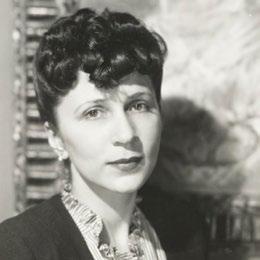
16. Julia Michel Black (American/Louisiana, d. 1968, active Newcomb College, 1903-1907 & 1913-1916), “Still Life of Pottery”, oil on board, signed lower right, unfinished still life and “Taylor Clark, Fine Prints, Paintings and Framing, Baton Rouge, LA” label en verso, 14 1/4 in. x 11 1/2 in., framed, overall 18 1/2 in. x 16 in. x 1 5/8 in.
[$400/600]
Provenance: Collection of Dr. James Nelson, Gonzales, LA; Neal Auction, May 8, 2016, lot 1137.
Note: Julia Michel Black was a student at Sophie Newcomb College and a member of the Art Association of New Orleans and the Arts and Crafts Club of New Orleans.

17. Marie Tebo Williamson (American/Louisiana, early 20th c.), “Brulatour Courtyard”, oil on board, signed lower right, 20 1/8 in. x 13 3/4 in., framed, overall 21 1/2 in. x 15 1/4 in. x 3/4 in.
[$400/600]
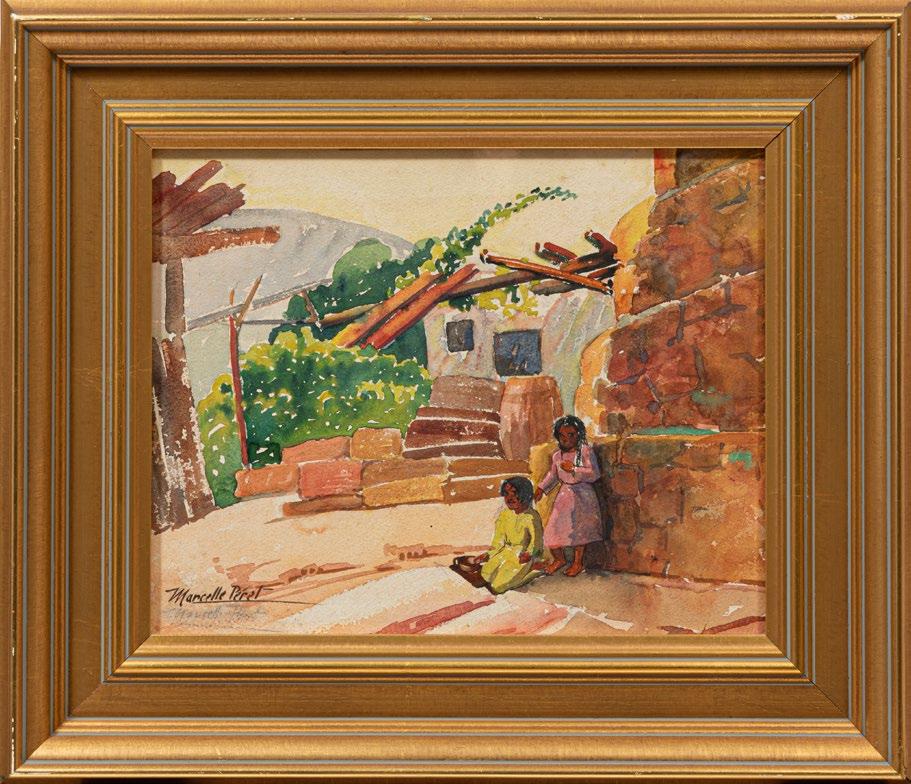
18. Marcelle Martinet Peret (American/Louisiana, 1898-1973, active Newcomb College, 1918-1923), “Children”, watercolor on board, signed twice lower left, “Jean Bragg Gallery, New Orleans, LA” label with provenance on backing paper, 10 1/8 in. x 12 5/8 in., framed, overall 15 5/8 in. x 18 3/16 in. x 1 5/8 in.
[$400/600]
Exh.: “Newcomb College Arts & Crafts Sales Exhibition”, Jean Bragg Gallery, New Orleans, LA, Oct. 30 - Nov. 30, 1998.
Note: Marcelle Martinet Peret was born in 1898 and was a student at Sophie Newcomb College from which she graduated in 1923. She is known for her colorful landscapes in watercolor and skillful cityscapes of New Orleans in graphite, with her style and choice of subjects likely heavily influenced by William and Ellsworth Woodward.
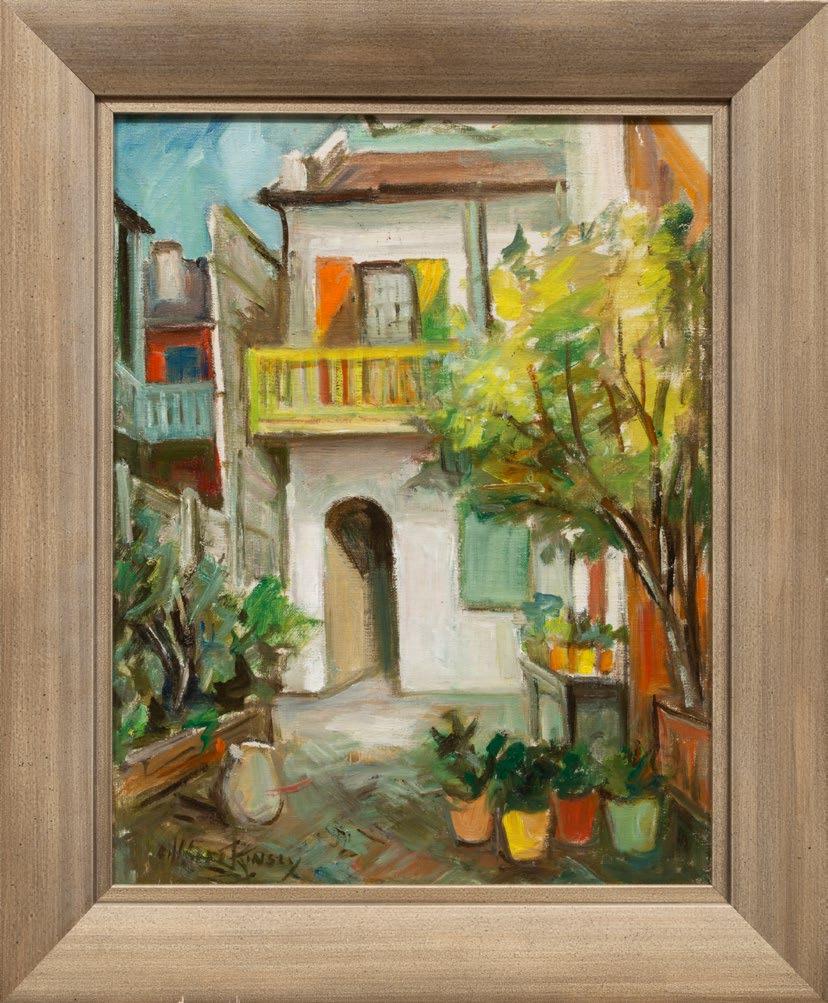
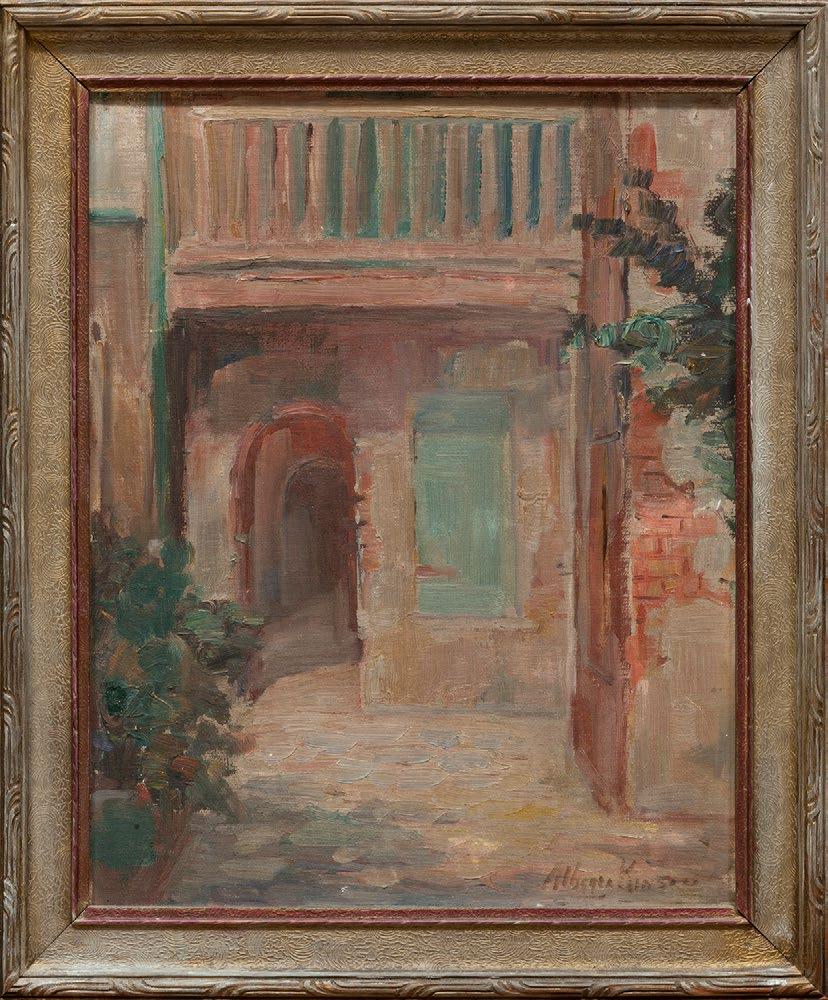
19. Alberta Kinsey (American/Louisiana, 1875-1952), “French Quarter Courtyard”, oil on canvas laid on masonite, signed lower left, 20 1/2 in. x 16 in., framed, overall 25 3/8 in. x 21 in. x 2 in.
[$600/800]
Note: Alberta Kinsey was born on a small farm in Ohio and attended a rural one-room schoolhouse before training at the Cincinnati Art Academy and the Art Institute of Chicago. In 1918, she moved to New Orleans and quickly developed a deep fondness for the French Quarter, despite the fact that it was considered a less than desirable neighborhood for a woman living alone in the early twentieth century. Renting an apartment and studio in the Old Governor Claiborne Home at 628 Toulouse Street, Kinsey hosted the first meeting of the Arts and Crafts Club of New Orleans and found herself at the center of the burgeoning artistic community in the city. Her love of the historic buildings, cobblestone streets, and plant-filled courtyards inspired her to depict many scenes of French Quarter daily life. She has said of her early years in the city: “I didn’t have a great talent or the genius for it, but I did have the desire. It was love at first sight, even before I had seen a patio or mounted a creaky stair in the old houses I love so much.”
Ref.: Saward, Susan. “Alberta Kinsey.” 64 Parishes. www.64parishes.org.
Accessed May 2, 2024.
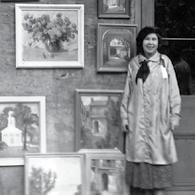
20. Alberta Kinsey (American/Louisiana, 1875-1952), “French Quarter Courtyard”, oil on canvas board, signed lower right, “Farish Art Store, New Orleans, LA” label on reverse of frame, 14 in. x 11 1/4 in., framed, overall 16 3/4 in. x 14 in. x 1 1/8 in.
[$800/1200]
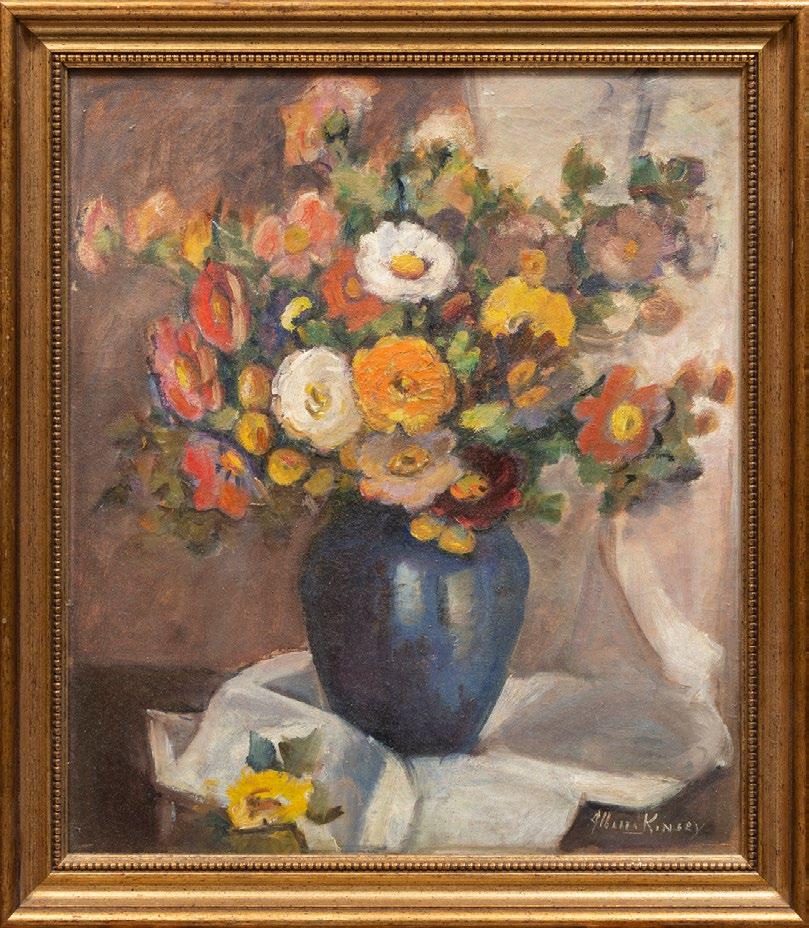
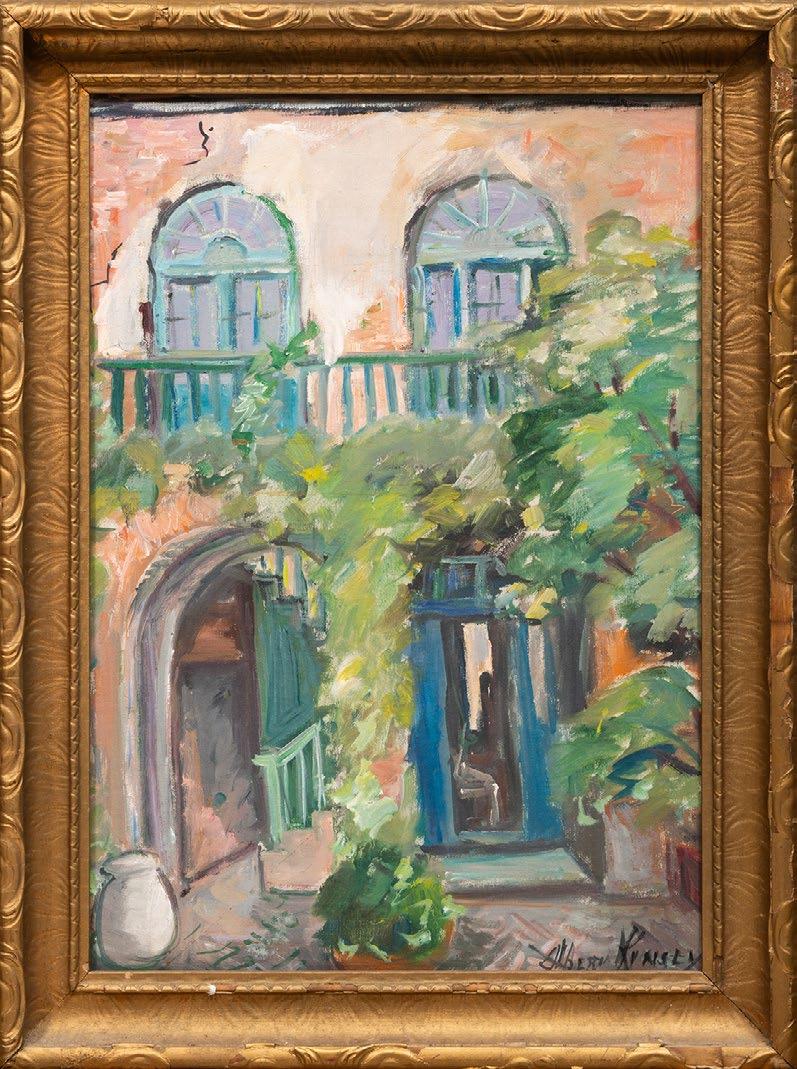
21. Alberta Kinsey (American/Louisiana, 1875-1952),
“Still Life of Flowers”, oil on canvas, signed lower right, 22 7/16 in. x 19 1/4 in., framed, overall 25 3/4 in. x 22 5/8 in. x 1 3/4 in.
[$1200/1800]

22. Alberta Kinsey (American/Louisiana, 1875-1952),
“The Iron Gate, French Quarter Courtyard”, oil on canvas board, signed lower right, remnant of signature lower left, “J.K. Baker, Pictures and Framing, Dayton, Ohio” label en verso, 17 in. x 13 1/8 in., framed, overall 19 3/4 in. x 15 7/8 in. x 1 1/2 in.
[$1000/1500]
23. Alberta Kinsey (American/Louisiana, 1875-1952), “French Quarter Courtyard”, oil on canvas, signed lower right, 20 in. x 14 in., framed, overall 23 7/8 in. x 17 7/8 in. x 1 3/4 in.
[$1000/1500]

24. Colette Pope Heldner (American/Louisiana, 1902-1990), “Under a Cabildo Arch, Jackson Square, Old French Quarter, New Orleans”, 1932, oil on board, signed, dated and inscribed “New Orleans” lower left, signed, titled and dated en verso, 14 15/16 in. x 11 3/4 in., framed, overall 18 3/8 in. x 15 5/16 in. x 1 3/8 in. [$1500/2500]
Note: Wisconsin-born, Dorothy Colette Pope Heldner was raised in Duluth, Minnesota. A strong-willed, independent child and adolescent, Colette once ran away from home and cut off her hair, securing a job as a delivery boy for Western Union. Her deception was revealed when her mother recognized and apprehended her on one of her deliveries and dragged her home. Later she had a job as the secretary at Rachel McFadden Art Studio. It was there, while taking classes, that she eventually met her future husband in her instructor, Swedish artist Knute Heldner. The couple eloped in 1923 and, to find reprieve from the Minnesota winters, traveled to New Orleans. That fateful trip would alter the trajectory of their lives, and they spent a large part of their life together alternating between New Orleans winters and Minnesota summers. They also spent time from 1929 to1932 traveling throughout Europe. As Sara Saward points out: “Colette’s images of Paris are filled with abundant and humorous anecdotal detail: boisterous café clientele, fashionable women walking poodles, and sailors ogling brazen streetwalkers, all drawn as caricatures.” This same style in which she documented the Quartier Latin was later transposed to her French Quarter scenes as she considered the two neighborhoods similar. Her sensitive portrayals of quaint French Quarter courtyards captured the romantic beauty of the city.
The Heldners, upon their return to New Orleans, applied their impressionist, loose brushstrokes and unique visual language to the surrounding landscapes, reviving
the more strictly rendered, Barbizon-like bayous of their predecessors such as Richard Clague, William Henry Buck and Joseph Rusling Meeker. Their fresh interpretations breathed new life into the genre, and she and Knute became integral fixtures of the New Orleans art scene.
Following Knute’s death in 1952, Colette’s style became more expressionistic and her palette free, more brash and vibrant. She began executing her “Swamp Idylls” with improvised flourish as if to capture on canvas the wild forms of the bayous. While married, she was a devoted wife. While widowed, she was able to focus on her craft, reputedly then saying, “I am the only artist in the family!”
Ref.: Saward, Susan. “Colette Pope Heldner.” 64 Parishes. Sept. 12, 2012. www.64parishes.org. Accessed May 2, 2024.


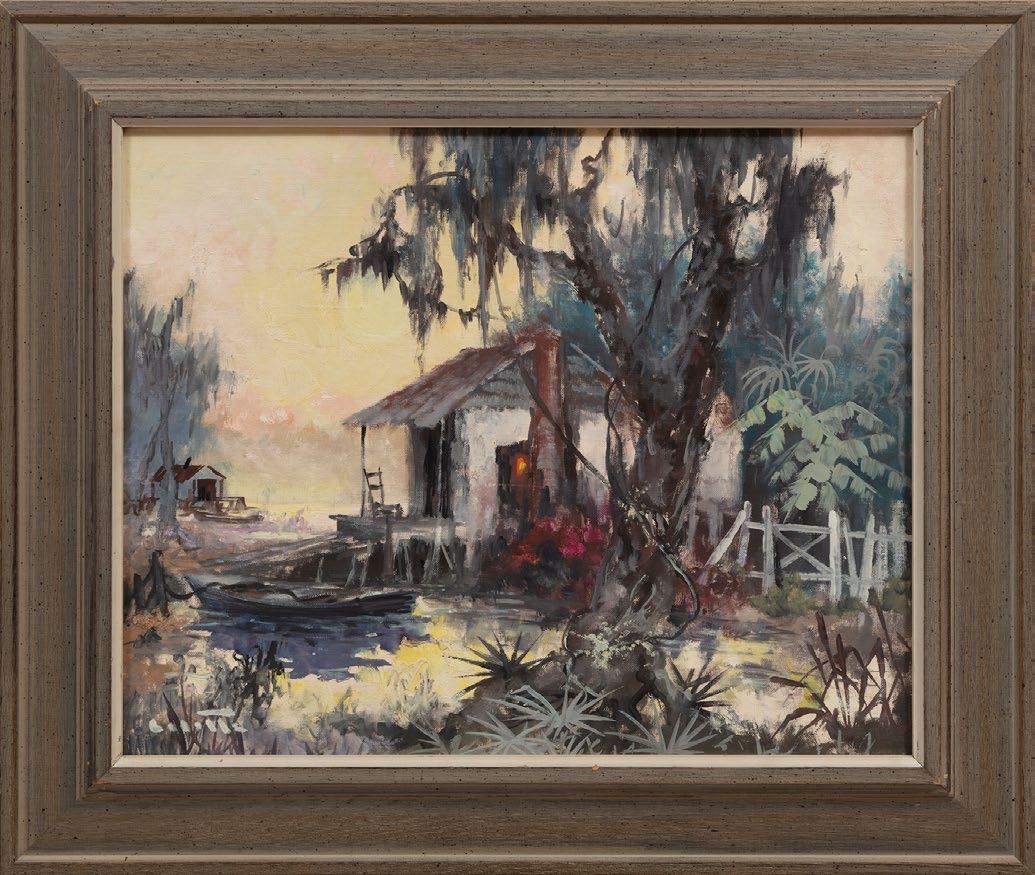

27. Stella Drabkin (American/Pennsylvania, 1906-1976), “Orange Tabby Cat on Stoop”, 1939, oil on canvas, signed and dated lower left, 12 in. x 10 in., framed, overall 15 3/8 in. x 13 3/8 in. x 1 1/2 in.
[$600/800]
Note: Stella Drabkin was an artist born in 1906 and raised in New York City. She was known for her experimental printmaking techniques, saying “an artist should work in various media, depending on the ideas he intended to express.” In the 1930s, Drabkin relocated to Philadelphia where she quickly integrated into the local arts community and began making prints depicting life the city. In 1933, she was the first prize recipient for the Gimbel Competition. Throughout her artistic career, she won many awards, including the American Color Print of Society Prize (1944), the Katzman Prize of the Print Club of Philadelphia (1955), and the New Jersey State Museum Purchase Prize (1967). In 1966, Drabkin designed the UNICEF calendar.
Ref.: Haber, Beth. “Stella Drabkin.” Jewish Women’s Archive. www.jwa.org. Accessed May 2, 2024.

28. Ruth Atkinson Holmes (American/ Mississippi, 1909-1981), “Reflecting Light on the Homestead”, 1957, oil on canvas board, signed and dated lower right, inscribed en verso, 16 in. x 20 in., framed, overall 18 7/8 in. x 22 7/8 in. x 1 1/2 in.
[$250/350]
Note: Ruth Atkinson Holmes was born in 1909 in Hazlehurst, Mississippi. She pursued her artistic studies at Tulane University, Mississippi University for Women, Southwest Mississippi Junior College and Mississippi College. She was part of a trio of Mississippi artists called the “Summit Trio,” along with Bess Phipps Dawson and Halcyone Barnes. The group met in Kentwood artist, Roy Shultz’s class at Southwest Mississippi Junior College in Summit in 1951 and studied, painted and exhibited together frequently for the following three decades.

29. Marie Atkinson Hull (American/Mississippi, 1890-1980), “Mississippi Coast”, oil on masonite, signed lower right, 20 in. x 24 in., framed, overall 22 1/4 in. x 26 in. x 2 in. [$6000/8000]
“Progress and change are the essence of living – for artist and non-artist. Without it, stagnation and deterioration soon become evident. People who expand their knowledge and investigate, remain more youthful, have joyous experiences, and become more mentally alert.” – Marie Hull
Note: Marie Hull was one of Mississippi’s most beloved and prolific artists. Her career spanned seven decades and resulted in a remarkable body of work which displayed her unwavering commitment to growth and experimentation. Hull was born in Summit, Mississippi in 1890 and had her first art lesson in 1910 with Aileen Phillips, who was the only trained art teacher in Jackson at the time. Hull quickly acknowledged her passion and talent for painting and soon enrolled at the Pennsylvania Academy of the Fine Arts in Philadelphia for one year, followed by a stint at the Art Students League of New York. Returning to Jackson, she gave art lessons in her home and worked as a commercial artist and illustrator. In 1917, Hull married Emmett Johnston Hull who encouraged her painting, and the couple traveled extensively. Around 1920, Hull’s stylistic personality as an artist began to emerge following extensive studies under some of America’s best artists.
The paintings of birds created by Hull during her 1925-1926 stay in St. Petersburg, Florida are among her most vibrant, beautiful and desirable works, often juxtaposing the naturalistic poses of the birds with stylized Art Deco depictions of fruit and flora. In

the spring of 1929, Hull commenced an eight-month journey that would be one of the most inspirational and important periods of her career. Massachusetts artist George Elmer Brown, who was living in France at the time, ran a series of travel study programs which provided students, and other established artists such as Hull, the opportunity to visit various countries for artistic study of the landscapes and cultures. Hull’s own passion for landscape, as evidenced by her earlier travels throughout the United States, was a perfect fit for the program.
During the mid-to-late 1930s, Hull traveled to every exhibition she could afford to attend and completed a series of powerful portraits of Mississippi tenant farmers (sometimes titled Sharecroppers) and Black workers. The sitters were often neighbors from nearby farms, and she was fascinated by the beauty she saw in them. Much as she explored various styles, Hull also tried her hand at many different media and became known for her rich color palette. She often joked that she liked any color, as long as it was pink. As her reputation grew, she was commissioned to paint prominent Mississippi figures, and her paintings became highly sought-after. (continued)

30. Marie Atkinson Hull (American/Mississippi, 1890-1980), “Tropical Oasis with Palm Trees”, oil on masonite, unsigned, “Robert F. de Castro, New Orleans, LA” label on reverse of frame, 28 1/4 in. x 37 7/8 in., framed, overall 33 in. x 43 in. x 1 1/2 in. [$2500/3500]
Provenance: Neal Auction, June 22, 2019, lot 140.
Beginning around 1940, she began to experiment by including flat, interlocking planes of color to interpret the landscape of Mississippi, inspired by Abstract Expressionism, the contemporary art of the day, and encouraged by her student, Andrew Bucci. By the 1960s, Hull was painting in a fully developed Abstract Expressionist style. Although her paintings often displayed the influence of great artists throughout the decades, Hull was able to maintain her own voice and vision within her work. Very much inspired by her own surroundings, she once stated that her ideas came from: “a street pavement’s cracks, the rhythms and patterns formed by rocks in a gravel walk, the beauty of red Mississippi clay.” Hull left a magnificent artistic and personal legacy in Mississippi and made a lasting mark on American art history. Ref.: “Hull, Marie (1890-1980).” The Johnson Collection. www.thejohnsoncollection.org. Accessed May 2, 2024; Levingston, Bruce. Bright Fields: The Mastery of Marie Hull. Jackson: University Press of Mississippi, 2015; Norwood, Malcolm M., Virginia McGehee Elias and William S. Haynie. The Art of Marie Hull. Jackson: University Press of Mississippi, 1975.
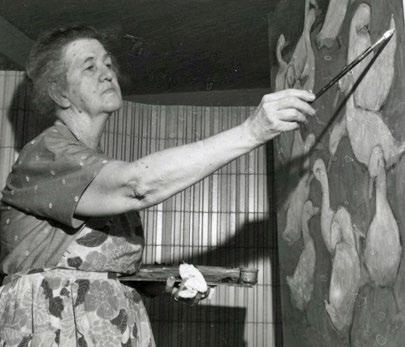

31. Rhoda Brady Stokes (American/Mississippi, 1902-1988), “Landscape with Farmhouse and Field of Corn”, 1962, oil on masonite, signed and dated lower right, 26 1/8 in. x 14 in., framed, overall 29 3/4 in. x 17 1/2 in. x 1 3/8 in.
[$700/1000]
Provenance: Neal Auction, Apr. 16, 2021, lot 668.
Note: Rhoda Brady Stokes was born in 1902 in the small town of Meadville, Mississippi. She moved to Baton Rouge after getting married, and she did not start painting until the 1950s after her children were grown. Known as Louisiana’s “Grandma Moses,” Stokes’ paintings often depict her childhood experiences as well as quaint genre scenes of the Acadians that lived in her adopted home of Louisiana.

32. Alice
(American/Mississippi, 1909-2004), “All Day
and Dancing on the Grounds”, oil on panel, signed lower right, signed and titled on reverse of frame, artist card on backing, 24 in. x 35 5/8 in., framed with title plaque, overall 33 1/8 in. x 43 3/4 in. x 3/4 in. [$2000/3000]
Provenance: Acquired from the artist.
Note: Alice Latimer Moseley began painting late in life at the age of sixty-five. When Moseley’s Alzheimer’s–afflicted mother moved in with her and her husband in the 1960s, Moseley painted to deal with the grief, depression and stress that came with being a full–time teacher at work and caretaker at home. After her mother’s passing in the early 1970s, Moseley’s son convinced her to try and sell the large body of work she had created while caring for her mother. She sold thirty paintings in one day in a Nashville flea market stall and decided that it was a sign to pursue art fulltime. Many of her works deal with southern people in varied and eccentric forms engaging in their daily lives and activities. While the levity with which she painted her subjects was born from a time of devastation, Moseley would often mention that without the pain of losing her mother, she would have never become an artist and viewed it as a precious gift that her mother gave her.
Ref.: “Alice.” Alice Moseley Folk Art Museum. www. alicemoseley.com. Accessed May 2, 2024.

33. Theora Hamblett (American/Mississippi, 1895-1977), “Red Rooster Atop the Chicken Coop”, 1977, oil on canvas, signed and dated lower right, 16 in. x 19 7/8 in., framed, overall 16 11/16 in. x 20 5/8 in. x 1 3/8 in. [$15000/25000]
Provenance: Acquired from the artist, 1977.
Note: Renowned for her self-taught painting style, Theora Hamblett became one of Mississippi’s most celebrated and distinguished artists. Hamblett began her professional career late in life at the age of fifty-five, eschewing the abstract style popular at the time in favor of subjects more personal. Over the ensuing twenty-two years, she developed an extraordinary oeuvre that is as unique as it is powerful. Many of Hamblett’s paintings concentrated on her childhood memories, especially of the chicken farm in Paris, Mississippi where she spent her childhood. In nearly all her landscape paintings, she included animals or people, with the belief that those additions gave life to the scenes. She also painted many landscapes that featured children playing games to evoke a sense of nostalgia. After an accident which broke her hip and required surgery in 1954, Hamblett began to paint her dreams and visions, many with religious themes and elements. The same year, New York gallery owner and famous collector, Betty Parsons, discovered Hamblett’s work and subsequently one of her paintings was included in a 1955 show of new acquisitions at the Museum of Modern Art. Hamblett’s paintings have two main hallmarks that set them apart – pattern and color. Almost obsessively flat areas of color off-set by the equally flat subjects are in dramatic
contrast to her distinctive and highly patterned trees. The effect of the foliage evokes movement, as each leaf is individually painted resulting in layers of color. Hamblett was a lifelong resident of Lafayette County in Mississippi, and upon her death in 1977, she willed most of her collection of paintings to the University of Mississippi, making them rare to the market today.
Ref.: Hamblett, Theora. Theora Hamblett Paintings. Jackson: University Press of Mississippi, 1975; “Theora Hamblett.” Greg Thompson Fine Art. www. gregthompsonfineart.com. Accessed May 2, 2024.


34. Clementine Hunter (American/Louisiana, 1886-1988), “Wedding”, oil on board, monogrammed lower right, 16 in. x 24 in., framed, overall 17 1/2 in. x 25 9/16 in. x 7/8 in.
Note: This lot has been authenticated by renowned Clementine Hunter expert Tom Whitehead. [$3000/5000
Note: Born near the end of 1886 on the notorious Hidden Hill Plantation in Marco, Louisiana, Hunter moved to nearby Melrose Plantation in 1902 and worked in a variety of positions from cotton picker to housekeeper and cook. The plantation was owned by John and Cammie Henry and later, after the death of John, Mrs. Henry retained the property and continued to plant, sell crops and maintain the grounds.
Melrose thrived under her care, and Mrs. Henry became known for her dedication to the arts and for her collection of historic and culturally significant items. She often hosted social gatherings for artists and writers, and Clementine Hunter, at the time a cook at Melrose, came across leftover paints and found inspiration to create her first paintings in the late 1930s or early 1940s. During this same period, François Mignon arrived at Melrose Plantation for a six-week visit that turned into a three decade long stay. He became the plantation’s historian and befriended Clementine Hunter. With both Mignon and Henry encouraging Hunter to paint, she became committed to her art, creating not only beautiful small-scale paintings on canvas and board, but also large-scale murals which decorated the structures on the property.
Hunter’s compositions reflected daily life at Melrose, and in her thick brushstrokes and strong primary colors, she documented the lively scenes that surrounded her from the labor-intensive cotton harvesting and pecan picking to the leisurely
pursuits of Saturday nights at the juke joint. Hunter’s unique style and vision captured an integral part of southern history, and she was well-recognized in her lifetime for her artistic achievements with many exhibitions. Like so many artists, she had an intense desire to create, and her subsequent oeuvre is one that continues to receive global recognition and accolades to this day.
Ref.: Gilley, Shelby R. Painting by Heart: The Life and Art of Clementine Hunter, Louisiana Folk Artist. Baton Rouge: St. Emma Press, 2000; Wilson, James. Clementine Hunter: American Folk Artist. Gretna: Pelican Publishing, 1988; The Journal of François Mignon: 1957, from the François Mignon papers, #M-3889 in the Southern Historical Collection, University of North Carolina, Chapel Hill, pp. 88-90.
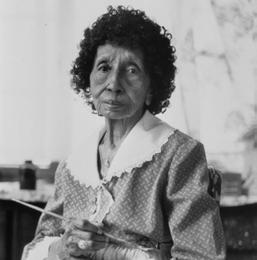

35. Clementine Hunter (American/Louisiana, 1886-1988), “Melrose Plantation Auction”, oil on board, monogrammed lower right, 23 1/4 in. x 24 in., framed, overall 32 1/4 in. x 33 in. x 1 3/4 in.
Note: This lot has been authenticated by renowned Clementine Hunter expert Tom Whitehead. [$5000/7000]

36. Clementine Hunter (American/Louisiana, 1886-1988), “Bouquet of Zinnias”, 1973, oil on canvas, monogrammed lower right, inscribed with date on stretcher, 36 in. x 24 in., framed, overall 38 in. x 36 in. x 2 in. Note: This lot has been authenticated by renowned Clementine Hunter expert Tom Whitehead. [$6000/8000]

37. Clementine Hunter (American/Louisiana, 1886-1988), “Vessels”, 3 paint on found vessels, 2 glass and one stoneware, 2 monogrammed twice, one monogrammed once, h. 8 1/4 in., dia. 3 3/8 in. to h. 11 in., dia. 2 3/4 in.; accompanied by a Polaroid photograph of the artist with the painted green glass vessel and New Orleans, Dec. 1985 issue magazine featuring Downtown Gallery and Clementine Hunter. (5 pcs.) Note: This lot has been authenticated by renowned Clementine Hunter expert Tom Whitehead. [$3000/5000]

38. Clementine Hunter (American/Louisiana, 1886-1988), “Saturday Night at the Juke Joint”, oil on canvas board, monogrammed lower right, partial sketch and inscribed en verso, 18 in. x 24 in., framed, overall 18 7/8 in. x 25 in. x 1 1/8 in. Note: This lot has been authenticated by renowned Clementine Hunter expert Tom Whitehead. [$4000/6000]
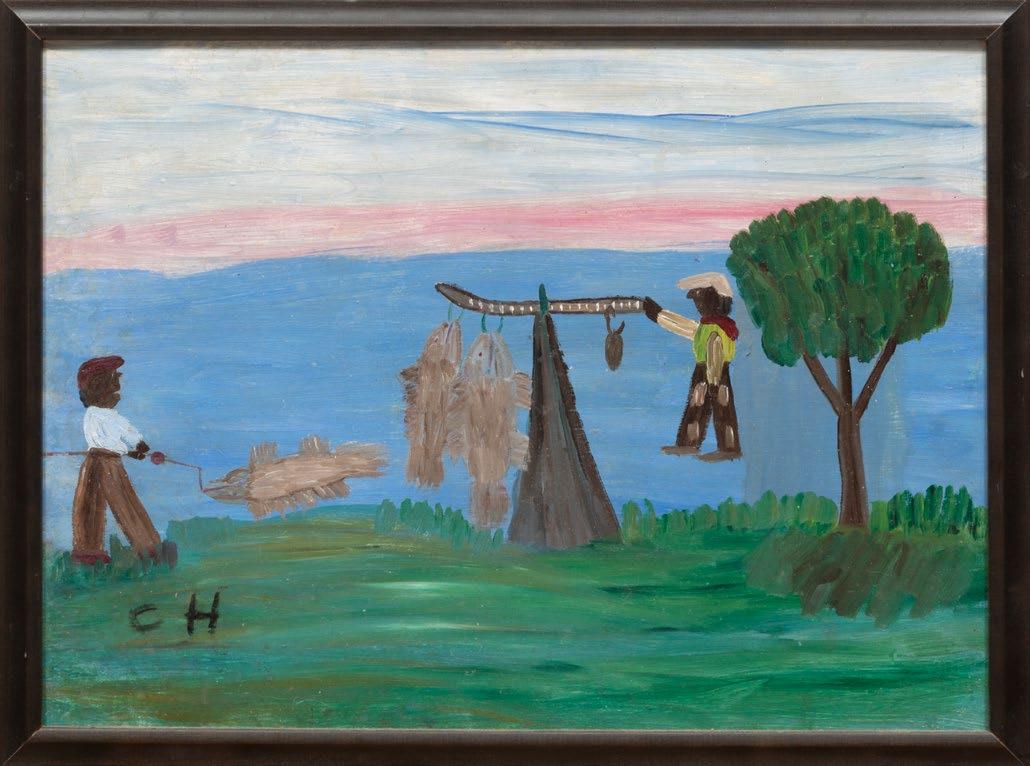
39. Clementine Hunter (American/Louisiana, 1886-1988), “Fishing”, oil on masonite, monogrammed lower left, 11 3/4 in. x 16 in., framed, overall 12 7/8 in. x 17 1/8 in. x 5/8 in. Note: This lot has been authenticated by renowned Clementine Hunter expert Tom Whitehead. [$4000/6000]

40. Annie Tolliver (American/Alabama, 1950-2018), “My Grandson Isaac Playing with Dog”, 1996, oil on panel, signed lower left, titled and dated en verso, 13 in. x 13 7/8 in., unframed. [$300/500]
Note: The daughter of artist Mose Tolliver, Annie Tolliver began drawing and sculpting using the natural materials found around her as a child. After watching her father’s career for years, Annie and her brothers, Charles and Jimmy, took a greater interest in his art and began painting in the same approach themselves. For a period of around five years, her work was sold with Mose T’s signature. After interest from a collector and with her father’s permission in late 1988, she began signing her work with her own name and gradually developed a style and following all her own. Tolliver’s work depicts memories of her childhood featuring brighter colors and more detail than her father’s. Her paintings have been included in exhibitions and publications nationally.
Ref.: “Annie Tolliver.” Marcia Weber Art Objects. www.marciaweberartobjects.com. Accessed May 6, 2024.

41. Mary Louise Proctor (American/Florida, b. 1960), “Railroad Snuff Dippers”, 1995, paint on found metal door, signed and dated lower right, titled upper center, 24 in. x 51 1/4 in., unframed. [$400/600]
Note: Mary Louise Proctor was born in Florida and raised by her grandparents. Even as a small child, she was frequently found preaching to everyone around her. Proctor worked in the nursing field and as the proprietor of a daycare before moving into the flea market business and collecting as a professional hobby. After a house fire tragically claimed the lives of her grandmother, aunt and uncle, Proctor turned to God and realized she was being instructed to paint. Her works are rooted in spiritual discovery and healing with Proctor’s vibrant figures pictured alongside insightful phrases inscribed throughout. Her first works were portraits of family members who had died in the fire, and set outside on the lawn, they caught the attention of curator
and critic Tricia Collins, who purchased them for her gallery in New York. Proctor had her first one-woman show at All Saints Gallery in Tallahassee in 1995 and a year later, a one-woman show at the Tricia Collins Grand Salon in New York. Proctor frequently signs her work as “Missionary Mary L. Proctor,” stating “I’m going to get a message out to broken women’s, a message to help and glorify them, so men can search their hearts, learn to respect us and treat us the right way.”
Ref.: Proctor, Mary. “Mary Proctor.” Souls Grown Deep. www.soulsgrowndeep.org. Accessed May 3, 2024.
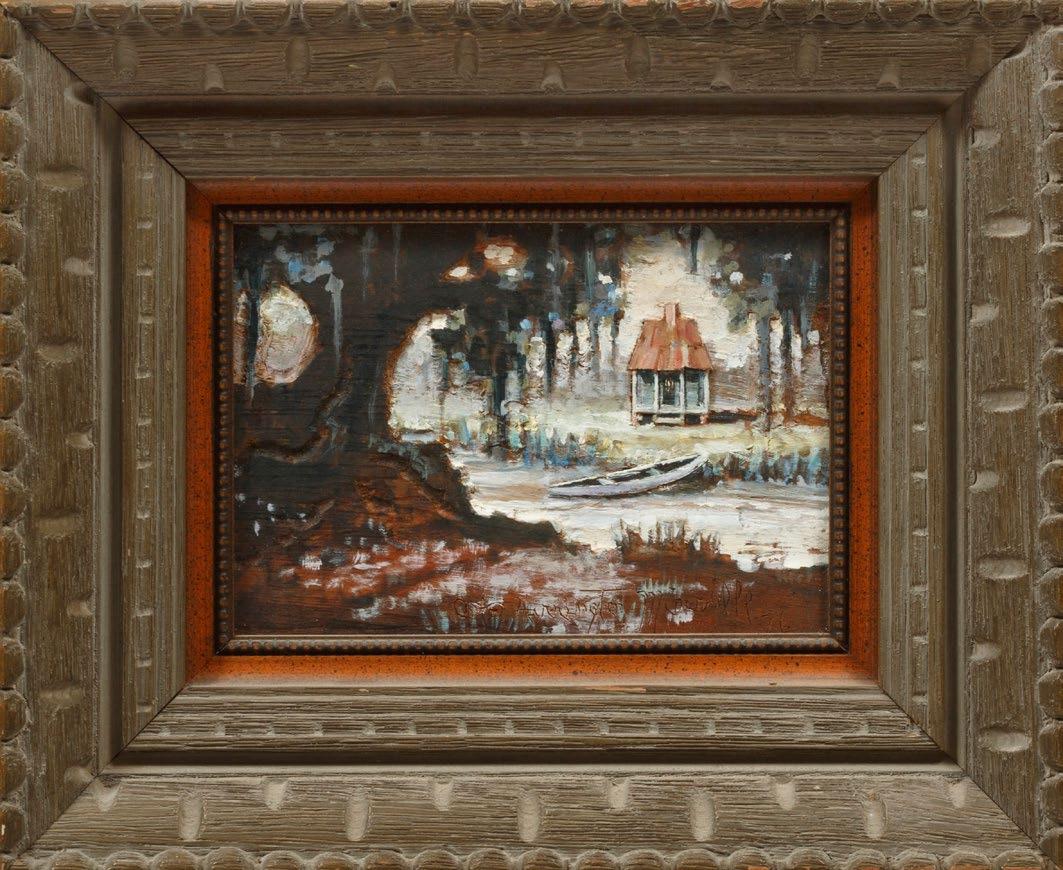

“For me the feeling of being inspired is the best and it comes through an urging of spirit. What a joy it is to hold raw material in my hands and let creation unfold. Then, when another discovers something issued unconsciously within the work and responds, there’s the magic of the unknown.” -Chestee Harrington
Note: Chestee Harrington grew up in New Iberia and exhibited an early interest in art. Her melting pot of a neighborhood, tucked between the Bayou Teche and the Old Spanish Trail, with its unique architecture and rich history serves as a continuous muse for her artwork. Harrington has spent decades honing her craft, frequently focusing on the luminous landscapes of her native Louisiana. In pairing paint with her carved wood reliefs, she creates unique scenes inspired by her surroundings and its fascinating history. She has said: “In pointing to nature, the French Impressionists were saying, ‘Look out into the world.’ The German painters said, ‘Look within.’ I look to spirit.”
Ref.: “About Chestee.” Chestee. www.chestee.com.
Accessed Apr. 30, 2024.
43. Chestee Harrington (American/Louisiana, b. 1941), “Walking to the Market”, 1990, oil on carved wood, signed and dated lower left, 17 in. x 10 in., unframed.
[$600/800]
42. Chestee Harrington (American/ Louisiana, b. 1941), “Landscape with Cabin and Pirogue”, 1976, oil on carved wood, signed and dated lower right, inscribed en verso, 5 7/8 in. x 7 in., framed, overall 9 1/2 in. x 11 1/8 in. x 2 in.
[$200/300]
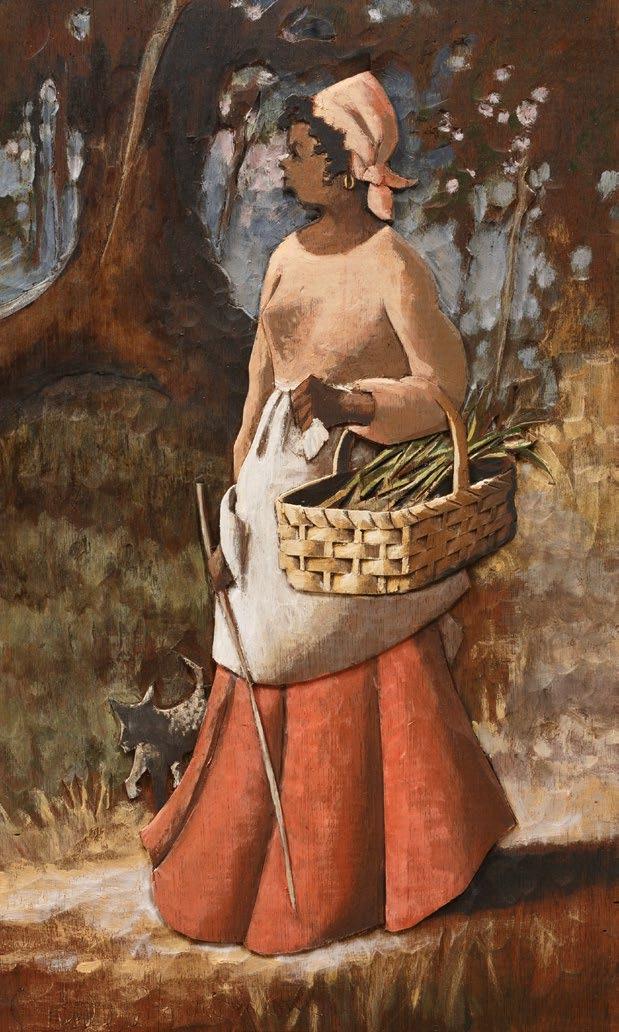

44. Thelma Park (American/Texas, 1901-1997), “Santa Ellena [sic] Canyon, Big Bend National Park”, oil on canvas, signed lower right, “Artists and Craftsman Associated, Dallas, TX” label with artist and title on stretcher, signed and inscribed on stretcher and backing board, 20 in. x 24 1/4 in., framed, overall 27 in. x 31 in. x 2 7/8 in. [$800/1200]
“Painting is a part of me. It is my life. I feel a closeness to my creator as I try to convey my interpretations of his handiwork.”
- Thelma B. Park
Note: Thelma Park was a respected landscape artist known for her stunning depictions of the American Southwest. She was a member of the Southwest Watercolor Society, Craftsmen of Dallas, American Artist Professional League and Texas Fine Arts and Artists. She founded and spent years teaching art at her Thelma B. Parks School of Art in Fort Worth, Texas.

Note: American Impressionist Martha Walter was born in 1875 in Philadelphia, Pennsylvania, and she studied under William Merritt Chase at the Pennsylvania Academy of Fine Arts. She traveled to Europe to further her artistic pursuits and develop her painting style. In Paris, she attended classes at the Académie de la Grande Chamiere and the Académie Julian but found their methods too constrictive and took to plein air painting in Parisian cafes and parks instead. Walter eventually moved back to the United States and worked in a studio in New York City. She enjoyed painting beach scenes of Coney Island and Gloucester where she eventually founded an art school and taught classes. She exhibited in the annual Pennsylvania Academy and Art Institute of Chicago shows and won a gold medal at the former in 1923.
Ref.: “Martha Walter.” Taylor Graham. www.taylorandgraham.com. Accessed May 6, 2024.
45. Martha Walter (American/ Pennsylvania, 1875-1976), “Marine Scene”, watercolor on paper, signed lower right, “Guarisco Gallery, Washington, D.C.” label on backing board, 15 3/8 in. x 20 in., framed, overall 25 in. x 29 3/4 in. x 1 1/2 in. [$1500/2500]
Provenance: Michael W. Murphy, El Dorado, AR.

46. Mary Nicol Neill Armour (Scottish, 1902-2000), “Calm Day, Corrie”, 1963, oil on canvas, signed and dated lower left, titled on reverse of frame, “Lyon & Turnbull, Edinburgh, Scotland” and “Aitken Dottson, Edinburgh, Scotland” labels on reverse of frame, 22 in. x 26 in., framed, overall 27 3/4 in. x 31 3/4 in. x 2 1/4 in [$1000/2000]
Provenance: Michael W. Murphy, El Dorado, AR.

47. Hazel Guggenheim McKinley (American/Louisiana, 1903-1995), “Photo Day at Wellfleet School of Art”, 1947, watercolor, gouache and graphite on paper, unsigned, label with artist, title and date, “Dutch Art Gallery 46 Years 19652011” label and copy of the poem “Son of Hazel” by John King-Farlow on backing paper, 14 in. x 20 in., framed, overall 22 3/4 in. x 27 3/4 in. x 3/4 in.
[$500/800]

Note: Mary Armour studied drawing and painting at the Glasgow School of Art (GSA) from 1920 to 1925. She excelled at oil still lifes, landscapes and seascapes executed in a rich palette. Armour exhibited at many prestigious institutions beginning in the 1930s and throughout her lifetime, including the Royal Academy, Royal Scottish Academy, Royal Scottish Society of Painters in Watercolour, Scottish Society of Artists, and Glasgow Institute of the Fine Arts. She was awarded the Guthrie prize at the Royal Scottish Academy in 1937, elected an associate there in 1941 and earned full membership in 1958. In addition to her own artistic practice, Armour was a lecturer in still life painting at the GSA from 1951 to1962 and appointed honorary president in 1982.

Note: Hazel Guggenheim McKinley was the youngest daughter of the wealthy industrialist Benjamin Guggenheim and his socialite wife Florette. When she was eight years old, her father died on the Titanic. A life-long intense rivalry with her flamboyant older sister Peggy often focused on vying for the attention of men. In the 1920s and 1930s, Hazel lived in France and England where she studied art and married the Englishman, Denys King-Farlow. During World War II, Hazel came to New Orleans where her fourth husband Lt. Charles “Chick” McKinley, Jr. was stationed. Sadly, the young pilot was killed in the war effort. Hazel developed a deep appreciation for the city; however, and she permanently settled in New Orleans in 1969. Hazel’s colorful watercolor and oil paintings are full of life, often with a strong whimsical quality.
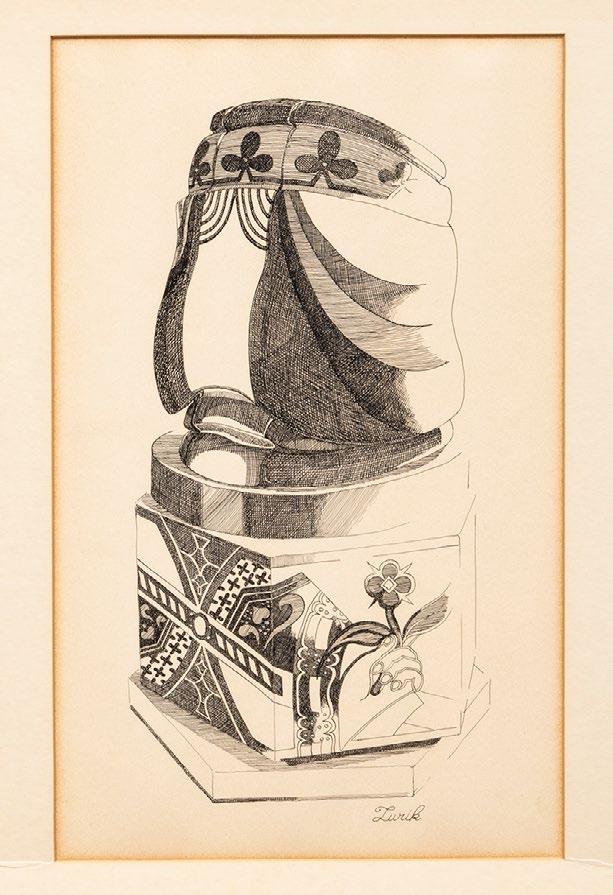

48. Jesselyn Benson Zurik (American/Louisiana, 1916-2012), “Untitled”, ink on paper, signed lower right, 13 3/4 in. x 11 in., matted, overall 17 1/2 in. x 12 in.
[$400/600]
Note: New Orleans native and important American minimalist artist, Jesselyn Benson Zurik excelled in creating sculptural assemblages imbued with architectural and industrial elements. Zurik attended Lafayette School and the Arts and Crafts School of New Orleans before enrolling in Isidore Newman School. While at Newman, she served as art editor of the Pioneer from 1931 to 1934. In 1934, Zurik then enrolled in Sophie Newcomb College at Tulane University, where she received a Bachelor of Design in 1938. During her time at Newcomb, Zurik studied under some of the great arts educators in the South of the time, including Xavier Gonzales, Will Henry Stevens and Caroline Durieux.
In the pre-war years, Zurik worked as an illustrator for Katz & Besthoff Drug Company, Adler’s Jewelry Store and D.H. Holmes. During World War II, she served as a naval draftsperson for Andrew Higgins of Higgins Industries. After the war, Zurik returned to a prolific art career, completing additional years of study at Newcomb College, and creating assemblage pieces, as well as oil paintings, charcoals and pen and inks. Zurik’s work hangs in numerous public and private collections throughout the United States, Canada, England, France, Israel, Italy and Switzerland. Her art was exhibited in over 250 juried or invitational shows and thirty-four one-woman shows. She received twenty-one awards for her exemplary artwork, which has been documented in fifty-six art publications. Zurik was an original member-artist of the Glade Gallery of New Orleans and had a one-woman show there in 1966.
49. Jesselyn Benson Zurik (American/ Louisiana, 1916-2012), “Untitled”, ink on paper, signed lower right, 11 in. x 13 3/4 in., unframed. [$400/600]


50. Jesselyn Benson Zurik (American/Louisiana, 1916-2012), “Untitled”, ink on paper, signed lower right, 11 in. x 13 3/4 in., unframed.
[$400/600]
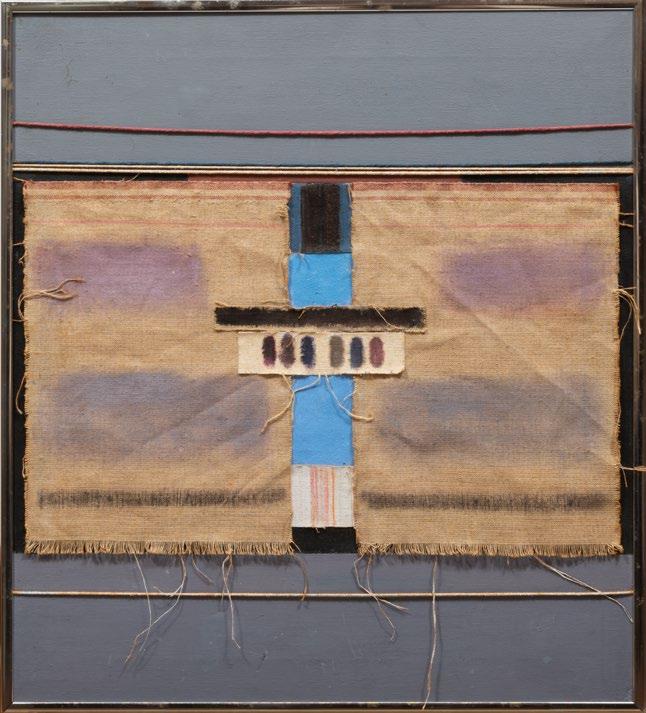

51. Althea Dodson Tanner (American/Louisiana, 1919-2014), “Western Image #6”, mixed media on canvas, handwritten label with title en verso, artist label on stretcher, 20 in. x 18 in., framed, overall 20 1/4 in. x 18 1/4 in. x 1 1/2 in.
[$300/500]
Note: New Orleans native Althea Dodson Tanner had a long and illustrious career as an artist, taking part in over one hundred exhibitions nationally and internationally and frequently winning awards and placing in juried shows. She attended Eleanor McMain High School, Augustine Business College and Sophie Newcomb College. Tanner traveled the world gathering inspiration for her work. An inventive and innovative creator, she was fearless in employing a variety of media from watercolor to clay and wrote poetry. Her abstract canvases showcase
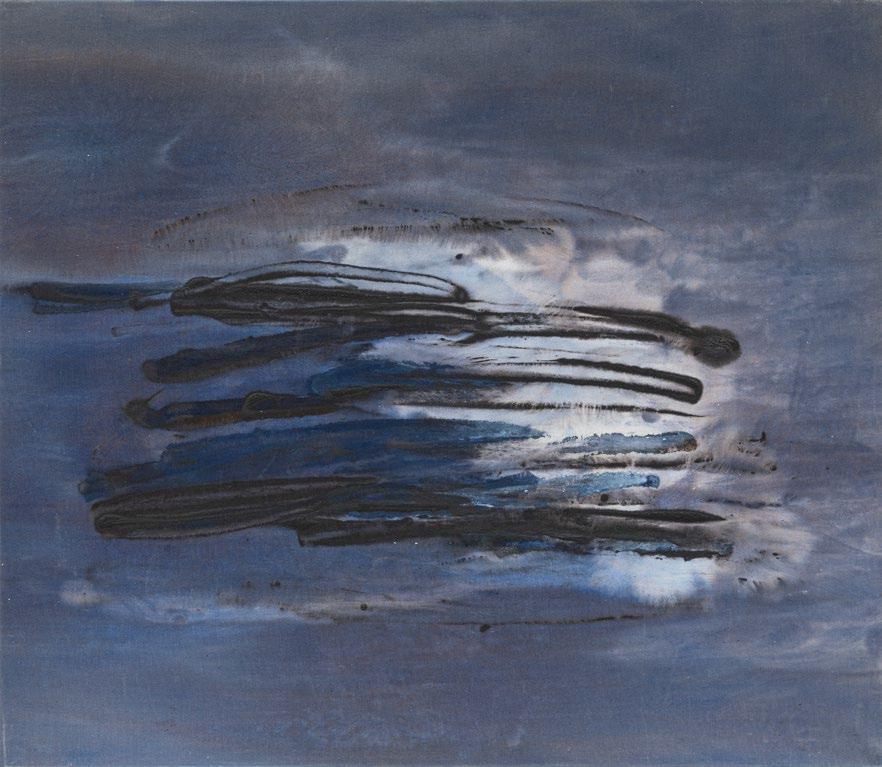
52. Cora Kelley Ward (American/Louisiana, 1920-1989), “Touched”, 1980, acrylic on canvas, signed, titled and dated en verso, handwritten tag with artist, title and date lower right, 34 1/4 in. x 39 5/8 in., unframed. [$2000/3000]
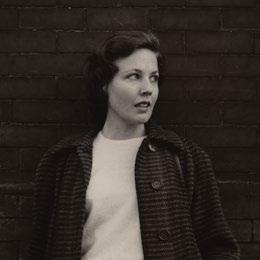 Cora Kelley Ward
Cora Kelley Ward
Note: Originally from Eunice, Louisiana, Ward moved to New Orleans at the age of seventeen. She worked as a registered nurse, eventually married Dr. Simon Ward and began taking classes at Newcomb Art School. In the late 1940s, her marriage deteriorated, and Ward fled New Orleans to follow her creative dreams. She enrolled at Black Mountain College to hone her skills and learn from some of the greatest and most innovative artists of the time. She befriended and worked alongside numerous soon to be world-renowned artists and intellectuals, including the formidable and highly admired art critic, Clement Greenberg, who became a close confidant. She continued her studies at the IIT Institute of Design in Chicago and eventually landed in New York in 1955.
New York at the time was the bustling apex of the contemporary art movement, and Ward had no trouble finding a place for herself, making friends with the city’s greats such Helen Frankenthaler, Robert Frost and the aforementioned Greenberg. Ward often remained behind the scenes and behind the camera at gallery openings, documenting her influential friends in attendance through her photography. The enigmatic Ward was at the center of the dynamic 1960s New York art scene and surrounded herself with the most successful luminaries of the day, many of whom whose work would later grace the most hallowed of museum walls. A passionate artist in her own right, Ward’s works stylistically followed those of her more famous cohorts with an aesthetic all her own, evident in her many experiments with a variety of media. Her role within the group, while long forgotten and much overlooked, is nonetheless incredibly significant in a realm boasting of few women. While the art world at the time was relegated primarily to men, they found their equal in Ward.
In March of 2021, Garden and Gun published an extensive profile of Ward written by John Ed Bradley. Through Bradley’s careful research, Ward’s place among her contemporaries was finally cemented.
Ref.: Bradley, John Ed. “Unearthing the Art of Cora Kelley Ward.” Garden and Gun. Feb./Mar., 2021. www.gardenandgun.com.
Accessed May 1, 2024.


53. Cora Kelley Ward (American/Louisiana, 1920-1989), “Indian Beat”, 1964, oil on canvas, signed, titled and dated en verso, handwritten tag with artist, title and date lower right, 56 in. x 56 in., unframed. [$3000/5000]
Note: Born in Mobile, Alabama, Raine Bedsole graduated from Auburn University and the San Francisco Art Institute. She has been active in the New Orleans art community since the early 1990s and works from a French Quarter studio. Bedsole is a prizewinner in the Florence Biennale and the recipient of a Joan Mitchell Foundation public sculpture grant. She spent much of her childhood on a farm, and her early experiences inspired a lifelong interest in nature. Natural forms and surfaces inform much of her work, which often includes nautical imagery. Her art is often described as haunting and serene, with “patinas and textures embodied with meaning.”
Ref.: “Biography.” Raine Bedsole. www.rainebedsole. com. Accessed Mar. 3, 2023; “Raine Bedsole.” Callan Contemporary. www.callancontemporary.com. Accessed Mar. 3, 2023; “Raine Bedsole.” Cumberland Gallery. www.cumberlandgallery.com. Accessed Mar. 3, 2023.
“There are no words to describe this feeling of wholeness which blooms in me… of being open to what is before me in great painting and drawing and sculpture.” – Cora Kelley Ward
54. Cora Kelley Ward (American/Louisiana, 1920-1989), “Untitled”, c. 1973, acrylic on canvas, unsigned, handwritten tag with artist, title and date lower right, 68 in. x 47 3/4 in., unframed. [$3000/5000]
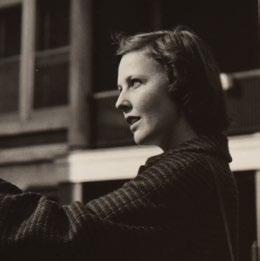


55. Jo Ann Greenberg (American/Louisiana, 1928-2013), “Three Graces”, glazed ceramic, signed, h. 18 1/2 in., dia. 8 in.
[$500/700]
Provenance: Duplantier Gallery, New Orleans, LA, c. 1984.
Note: Jo Ann Greenberg was a Tampa, Florida native who moved to New Orleans in 1947 to attend Sophie Newcomb College and never left. She married, raised three children and then returned to Newcomb in the 1960s to earn her MFA. Her unique pottery received national recognition and a devoted local following, and she later ran a crafts gallery, Alternatives, in the Riverbend neighborhood. Greenberg’s instantly recognizable work includes richly carved elements of Louisiana wetlands and cavorting nudes that fill her creations with movement, whimsy and joy.
56. Eleanor Creekmore Dickinson (American/Tennessee, 1931-2017), “Reclining Female Nude”, 1967, ink on paper, signed and dated lower left, artist label with signature and date, artist card and 2 artist information labels on backing, sight 39 1/2 in. x 26 1/4 in., framed, overall 49 in. x 35 1/2 in. x 1 3/4 in. [$400/600]
Note: Eleanor Creekmore Dickinson was born in 1931 in Knoxville, Tennessee. She moved to the Bay Area for her graduate studies at the San Francisco Art Institute and The California College of the Arts and immersed herself in the thriving radical art and political scene. She marched in protests and socialized in the same creative circles as Lawrence Ferlinghetti and Allen Ginsberg. Dickinson changed her appearance and accentuated her hair with bold, colorful dyes which she washed out every year when she returned to the South to document the practices of the Pentecostal revivalists. Her depictions of the worshippers were executed through a respectful lens with the goal of showing the sincerity of the congregation and their beliefs. She executed a large and diverse body of work including numerous figure studies utilizing a wide range of media over the span of her lifetime, and her works have been exhibited at institutions such as the Smithsonian, San Francisco Museum of Modern Art and the Library of Congress’ Archive of Folk Culture.
Ref.: Marble, Steve. “Eleanor Creekmore Dickinson, Beat-era artist who explored Pentecostal revivals, dies at 86.” Los Angeles Times. Mar. 16, 2017. www.latimes. com. Accessed May 1, 2024.

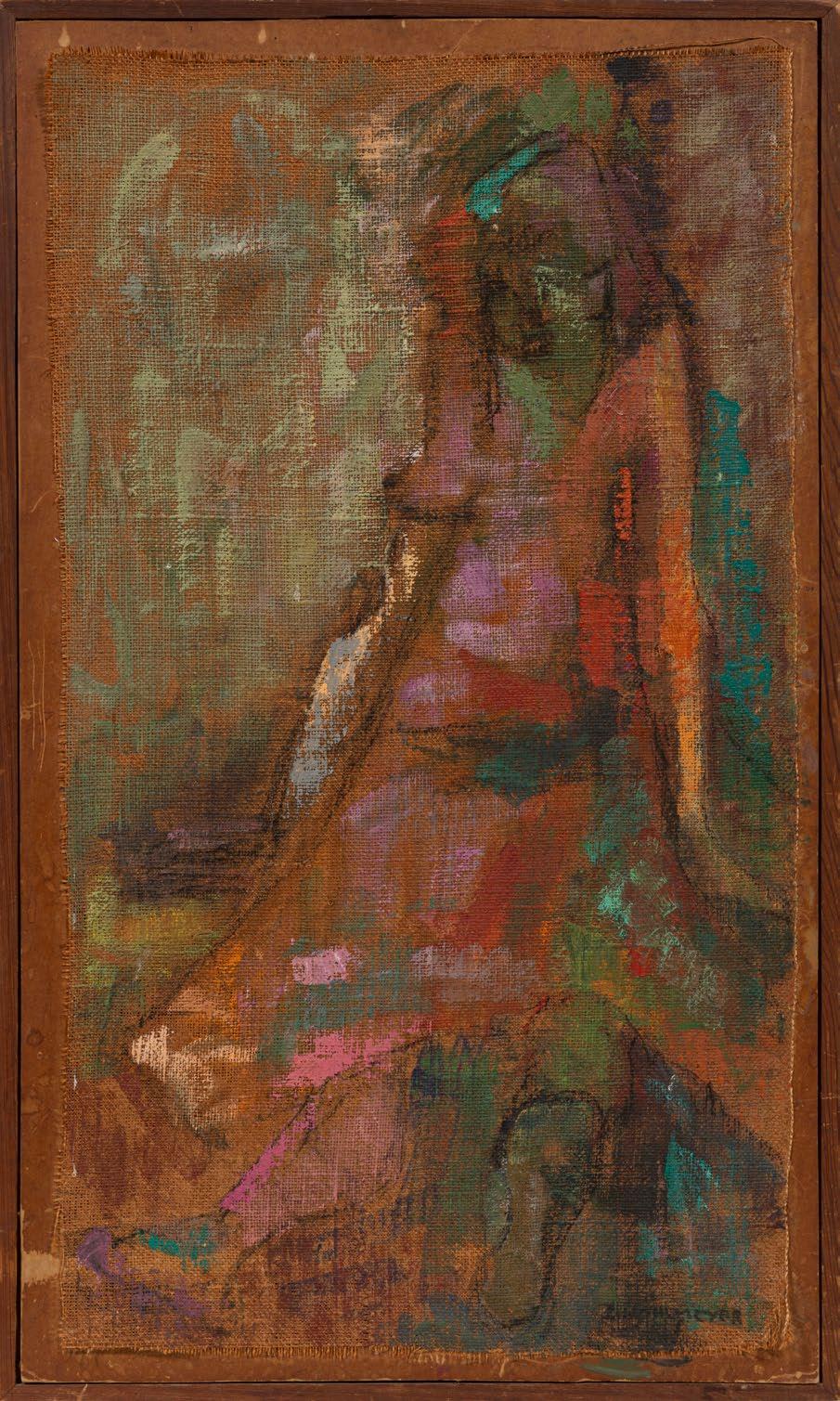
57. Ida Rittenberg Kohlmeyer (American/Louisiana, 1912-1997), “Seated Figure”, oil on unstretched burlap mounted on board, signed lower right, 35 5/8 in. x 20 3/8 in., framed, overall 38 1/2 in. x 23 1/8 in. x 3/4 in.
[$7000/10000]
Provenance: Acquired from the artist, c. 1955.
Note: A native of New Orleans, Ida Kohlmeyer achieved international acclaim as an artist and developed her own unique perspective on abstract art. She is widely considered one of the most influential artists from Louisiana and the South, although her art career did not begin until later in life. Following graduation from Sophie Newcomb College at Tulane University in 1933, Kohlmeyer married and raised a family. Dissatisfied with what she called a “vapid, dilettante life,” she first joined the John McCrady Art School in 1947, and then began classes at Newcomb College under the tutelage of Pat Trivigno in 1950. She eventually pursued a MFA, producing primarily figurative studies and representational work for her thesis. Following the completion of her degree in 1956, Kohlmeyer spent a formative summer at the art colony in Provincetown, Massachusetts studying under Hans Hofmann. Abstraction appealed to Kohlmeyer, and she likened her sudden shift from representation to being freed from prison. The following year, Mark Rothko came to New Orleans in a visiting artist position at Tulane and moved his family into the Metairie home of Ida Kohlmeyer’s late mother. The resulting friendship between Kohlmeyer and Rothko would have a profound influence on the trajectory of her work.
By the 1970s, Kohlmeyer had transcended the influences of Hofmann and Rothko and moved entirely to non-objective subject matter. She developed her own code of schematic symbols, which she often arranged in a grid pattern. These paintings are abstract, yet linguistic, and hint at the deep personal emotion behind them. While the symbols present a pictographic code, their meaning remains elusive.
Throughout her active career, Kohlmeyer successfully exhibited her work in prestigious galleries and museums nationwide, with over one hundred solo exhibitions. She received the National Women’s Caucus for Art’s outstanding achievement award in 1980 and was the subject of her first major retrospective exhibition at the Mint Museum in Charlotte, North Carolina in 1983. Kohlmeyer can be considered a matriarch among American artists, as she broke the mold for southern artists and women artists alike during her lifetime. Her legacy is one of joyful, colorful paintings and a generation of female creators who follow in her footsteps.
Ref.: Plante, Michael. Ida Kohlmeyer: Systems of Color. New York: Hudson Hills Press, 2004. Kessler, Jane. Ida Kohlmeyer: Thirty Years. Charlotte, NC: The Mint Museum, 1983.
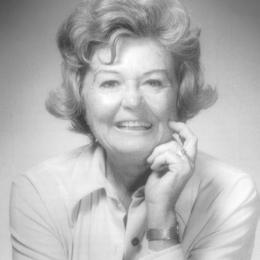

58. Ida Rittenberg Kohlmeyer (American/Louisiana, 1912-1997), “Block Drawing #1”, 1980, mixed media on board, signed, inscribed and “Galerie Simonne Stern, New Orleans” label with artist, title and date on backing board, 20 in. x 30 in., framed, overall 26 3/4 in. x 35 1/4 in. x 3/4 in. [$7000/10000]
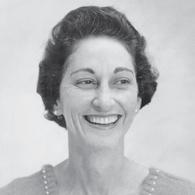
59. Dorothy Muriel Gillespie (American/Virginia, 1920-2012), “Untitled: Ribbons”, enamel on aluminum, signed, h. 12 1/2 in., w. 16 in., d. 16 in., acrylic base, overall h. 13 in.; accompanied by a copy of a receipt from Sue Lapin Art For Museums, Beverly Hills, CA, Jun. 3, 1985. (2 pcs.) [$600/800]
Provenance: The Estate of Caroline P. Ireland.
Note: Dorothy Gillespie was a pioneer in metal sculpture - a painter, sculptor and installation artist whose career spanned over seven decades. She became well-known for her colorful painted arrangements of cut aluminum strips, and her work evidenced many of the important trends in American Art of the twentieth century. Gillespie attended the Maryland Institute College of Art and then moved to New York City in 1943 to study at the Art Students League of New York and Atelier 17, a printmaking studio that emphasized experimentation. She moved with her family to Miami in the 1950s, where she often encountered discrimination in the art world, being labeled a “housewife painter.” As a result of these early experiences, she was later an active part of the feminist art movement in the 1960s and 1970s and dedicated much of her time to education and social activism. Gillespie was one of the first artists to display her work in lobbies of public institutions and government buildings such as the Mayo Clinic, Epcot Center, Miami Public Library and Fort Lauderdale Airport.

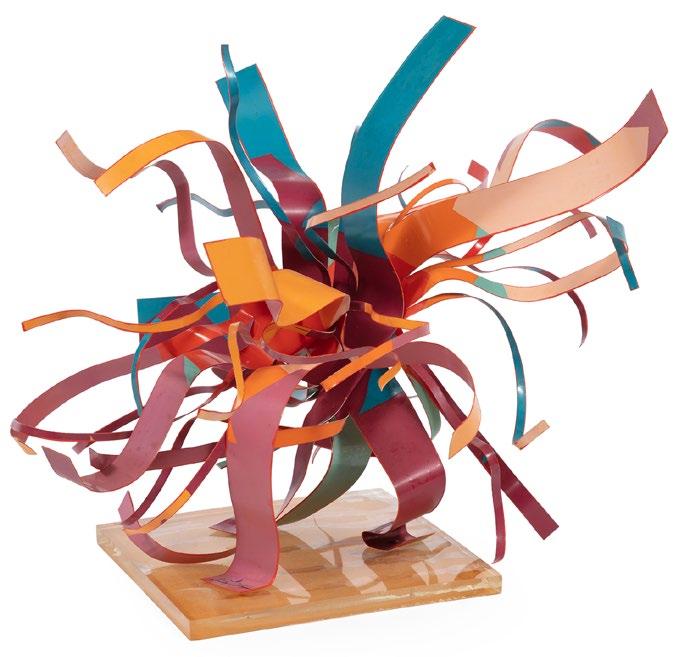
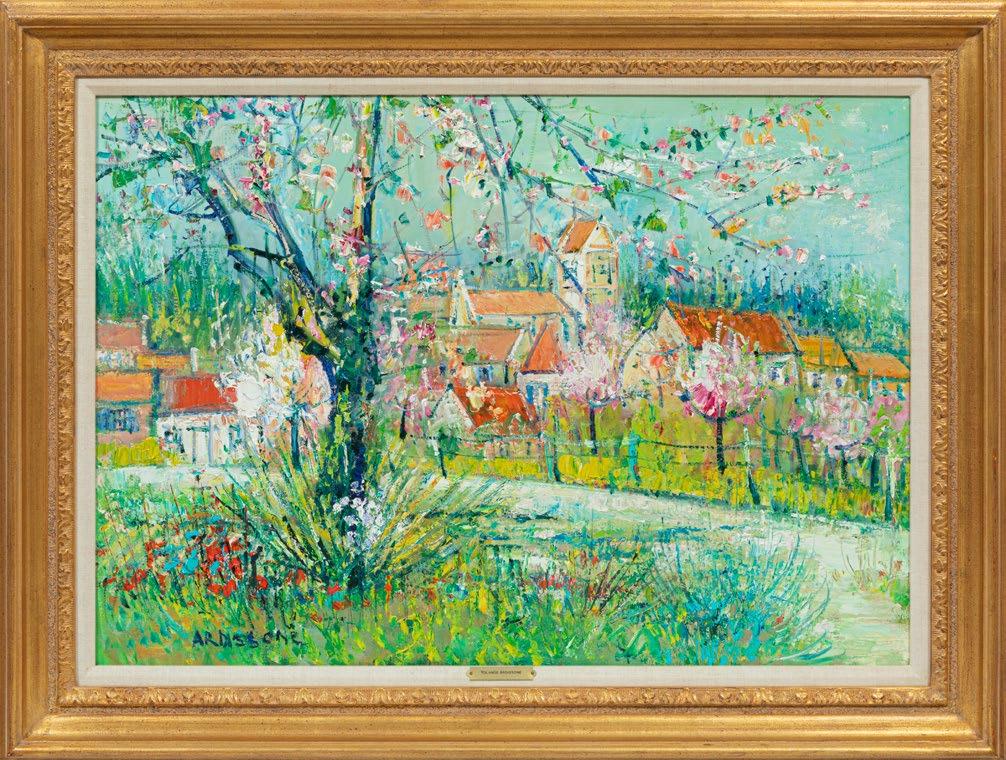
60. Yolande Ardissone (French, b. 1927), “Nanteau-sur-Essone”, oil on canvas, signed lower left, titled and inscribed “WF#1096095” on stretcher, inscribed with artist on reverse of frame, “Wally Findlay Galleries” label on reverse of frame and backing board, 25 7/8 in. x 36 1/2 in., framed with artist plaque, overall 33 1/4 in. x 44 in. x 2 in.
[$2000/3000]
Note: Born in Normandy, Yolande Ardissone left for Paris at the age of seventeen to study at the Ecole des Arts Appliqués and the Académie de la Grande Chaumière. After two years, she transferred to the Ecole des Beaux-Arts and shortly thereafter embarked on a journey to see the world. Despite her many travels, Ardissone is best known for her depictions of her native France, particularly Brittany. She has mastered a style reminiscent of the Fauves and strongly influenced by the Impressionist and Post-Impressionist masters such as Gauguin, Van Gogh and Renoir. The heavy impasto and expressive brushstrokes of her canvases provide a natural and spontaneous dynamism that is complemented by her vibrant color palettes. Ardissone has exhibited her works in many locations worldwide, including the famous Paris Salon where she earned an honorary mention in 1949. In 1957, gallerist Wally Findlay discovered her work and subsequently began exhibiting it in his galleries in New York City, Beverly Hills and Palm Beach.
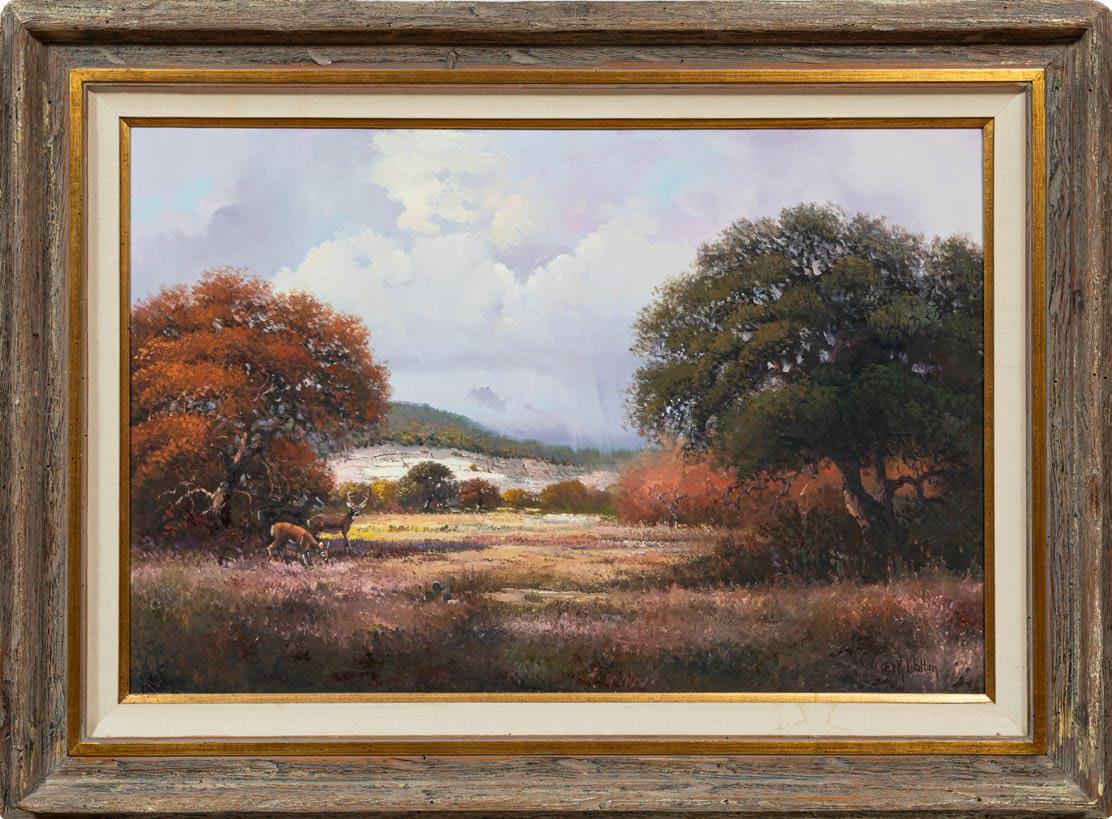
61. Kay Walton (American/Texas, 20th c.), “Autumn Respite”, oil on canvas, signed lower right, titled on stretcher, 24 in. x 36 in., framed, overall 34 1/8 in. x 46 in. x 2 1/4 in.
[$2000/3000]
Note: Kay Walton studied with noted artists William Henry Earle and Carole Pyburn, gaining a strong foundation in art theory that she has continually refined over her fortyyear career. Inspired by the sweeping Texas landscape, Walton is well known for her skillful depictions of light and her iconic bluebonnets. A native Texan, she travels frequently to the Hill Country to renew her connection to the natural beauty of the state and has also dedicated her time to teaching aspiring artists.
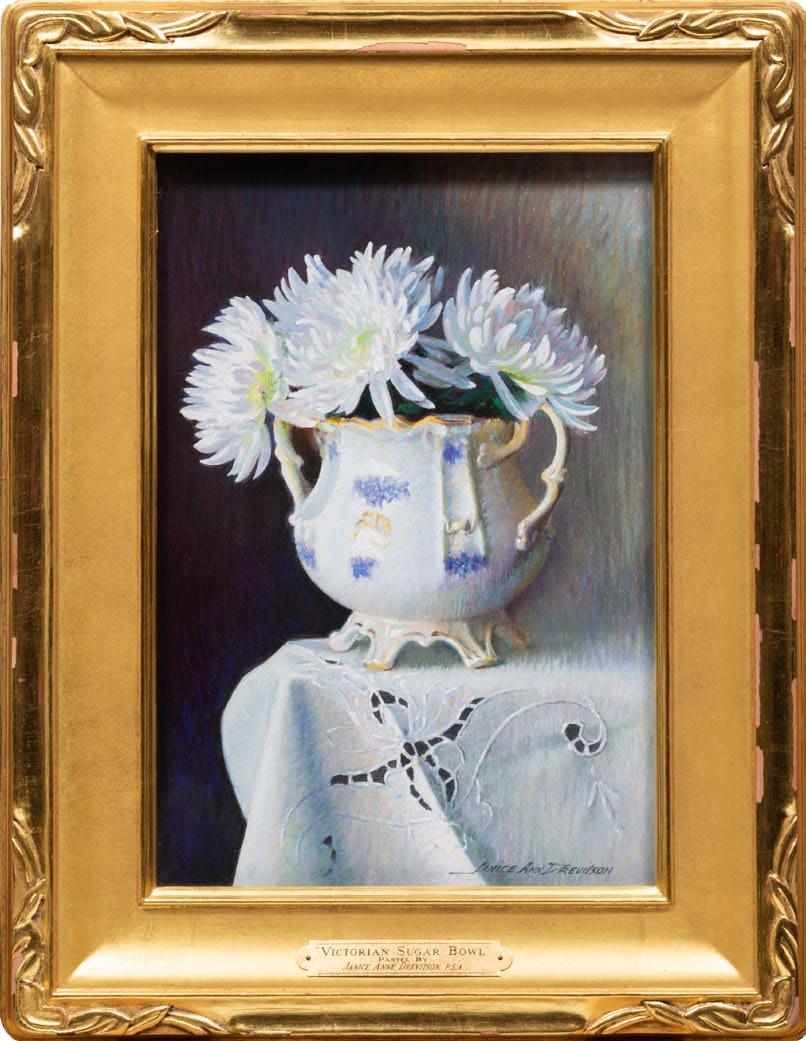

62. Janice Anne Drevitson (American/Vermont, 20th c.), “Victorian Sugar Bowl”, pastel on foamcore, signed lower right, titled, stamped, “Fox Gallery, Woodstock, VT” label, “Drevitson Galleries, Woodstock, VT” label and exhibition card on backing board, “For Pastels Only on Cape Cod” label with artist and title on reverse of frame, 11 in. x 16 in., framed, overall 22 1/4 in. x 17 1/4 in. x 1 3/4 in.
[$300/500]
Note: Janice Drevitson was raised in Malden, Massachusetts. She studied commercial art at the Vesper George School of Art in Boston, where she met her husband Neil Drevitson who was an artist and teacher at the college. Together they opened The Fox Gallery in Woodstock, Vermont where they displayed their own works, as well as works by local artists and a selection of decoy ducks, which Janice has a passion for collecting. Drevitson specializes in still lifes in the Boston School tradition. Of her process, she remarked: “I never work from photographs. I arrange everything in my studio and paint in real time.” She is involved in local arts communities such as the Guild of Boston Artists and The Copley Society of Boston.
Ref.: Lori Ferguson. “The Fox Gallery.” Woodstock Magazine 11.4 (Winter 2011-2012): 45-49.
63. Rise Delmar-Ochsner (American/Louisiana, b. 1944), “Self Portrait in Blue”, acrylic on canvas, unsigned, 48 in. x 48 in., framed, overall 49 1/4 in. x 49 1/4 in. x 1 in.
[$1500/2500]
Note: Rise Delmar Ochsner was born and raised in New York City where her mother was an artist. She graduated from Columbia University and Tulane Medical School in New Orleans where she practiced as an ophthalmologist for almost twenty years before retiring. She had discovered her own love of art while at Columbia and continued to paint through medical school and beyond. Ochsner earned commissions to paint Mick Jagger for a poster for his New Orleans tour stop, a portrait of Queen Noor of Jordan, Carol Burnett’s cat and fifty famous chefs for the Mondavi Winery. She relocated to Santa Barbara in 1995 to be a full-time artist, however, missing medicine, she returned to the practice in 2007. After nineteen years away, Delmar Ochsner moved back to New Orleans where she lives today saying: “I came back for the hugs…from my patients and my friends, and I’m delighted to be here again.” Her works have been featured in numerous exhibitions locally and nationally. While known primarily a figurative painter, Delmar Ochsner has an expressive, colorful style that translates beautifully to expansive landscapes, polo scenes and charming pet portraits.


64. Rise Delmar-Ochsner (American/Louisiana, b. 1944), “Floral Still Life”, acrylic on canvas, signed lower left, 28 1/4 in. x 30 in., unframed. [$600/800]
65. Rise Delmar-Ochsner (American/Louisiana, b. 1944), “Girl in White with Flowers”, acrylic on canvas, signed lower left, 48 in. x 48 in., framed, overall 49 in. x 49 in. x 1 1/2 in. [$800/1200]
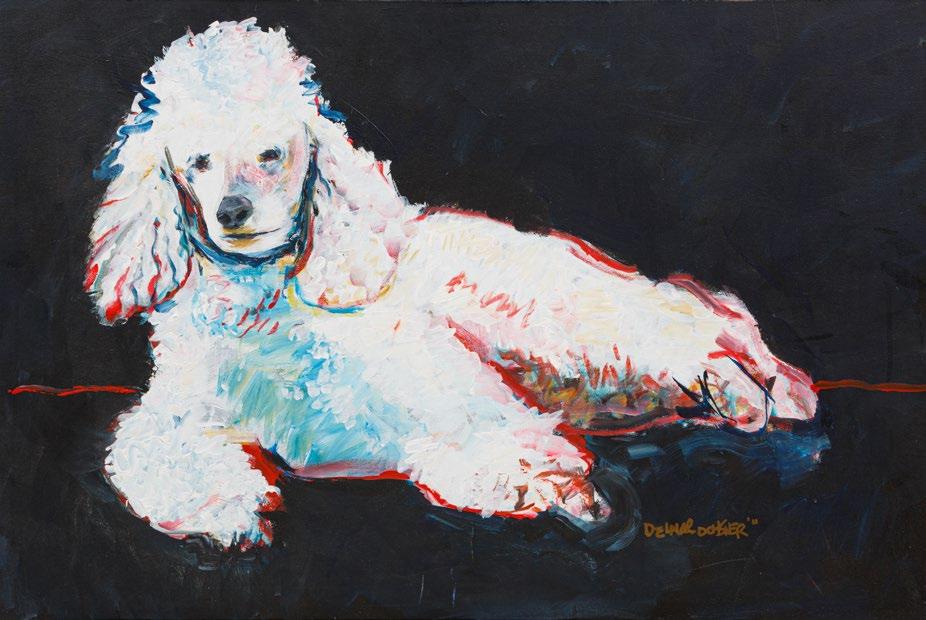
66. Rise Delmar-Ochsner (American/ Louisiana, b. 1944), “White Poodle”, 2011, acrylic on gallery-wrapped canvas, signed and dated lower right, 23 3/4 in. x 36 in., unframed. [$400/600]

67. Terri Thomas (American/Texas, 20th c.), “Untitled (Self)”, 2010, oil on paper, unsigned, label with signature, title and date on backing board, 9 7/8 in. x 7 3/4 in., framed, overall 11 5/8 in. x 9 1/2 in. x 7/8 in.
[$250/350]
Note: Currently residing in Austin, Texas, Terri Thomas studied painting at Corcoran College of Art + Design after becoming disenchanted with a career in the fashion industry. Her work examines ideas of “female sexuality (female assertion and autonomy), body-commodification, agency, contradictions of desire, temporality, beauty as strategy, high-brow art versus low-brow art, art historic patriarchy, parody and the staged body.” Ambiguity is at the heart of her photorealist work which encourages viewers to examine the representational and feminist norms that are embedded within Western society.
Ref.: “Biography.” Terri Thomas. www.territhomasart.com.
Accessed Apr. 30, 2024.
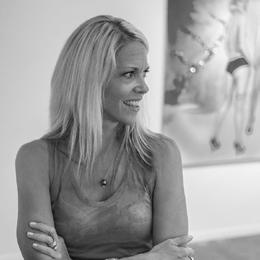
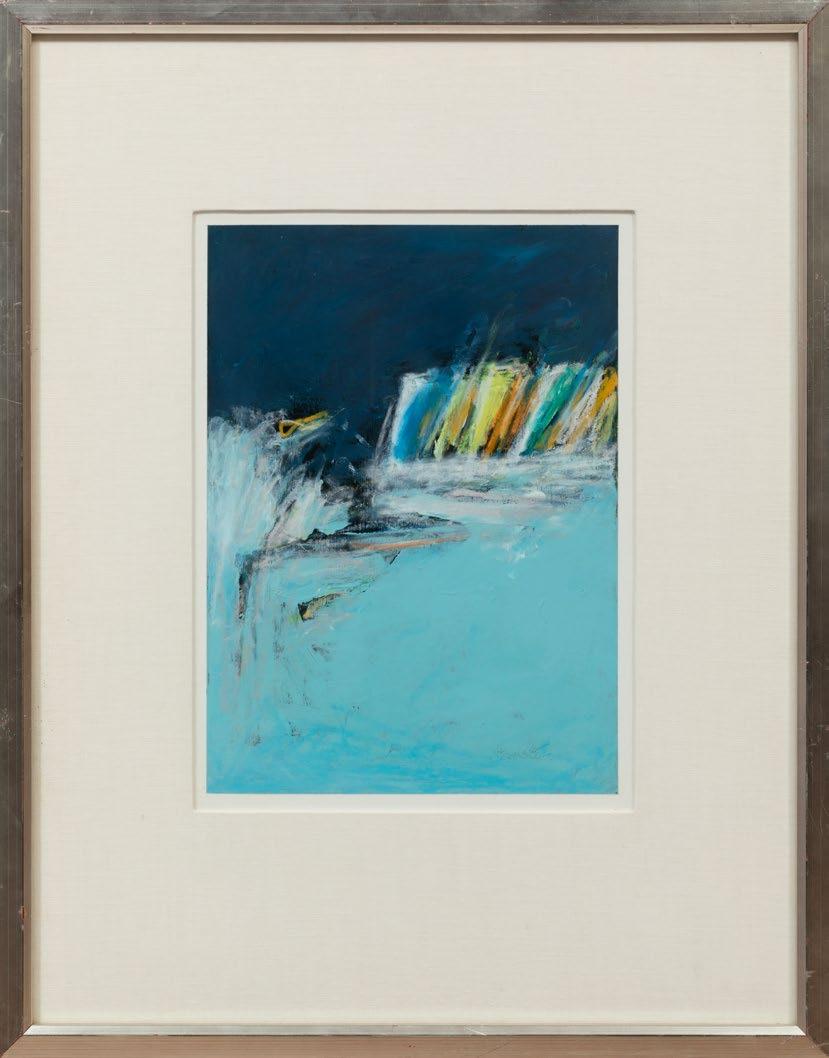
68. Nancy Harris (American/Louisiana, b. 1951), “Eye Care #1”, 1985, oil on paper, signed and dated lower right, signed, titled and dated upper center under mat, “Duplantier Gallery, New Orleans, LA” label and artist biography on backing paper, 20 in. x 14 3/16 in., framed, overall 25 1/4 in. x 19 7/8 in. x 1 in. [$300/500]
Note: Nancy Harris was born in 1951 in Texas. She has a MFA in painting and an MA in Art History and has studied extensively in Europe and Asia. She has exhibited in New Orleans as well as Washington, D.C. According to Duplantier Gallery “The things Ms. Harris chooses to paint about come from her life and time. She considers her pictures to be interpretations of small fragments. Sometimes they take on visual form as conscious symbols, but more often they are elusive and intangible. In either case, by elaborating and developing them, they become larger, universal and more meaningful.”
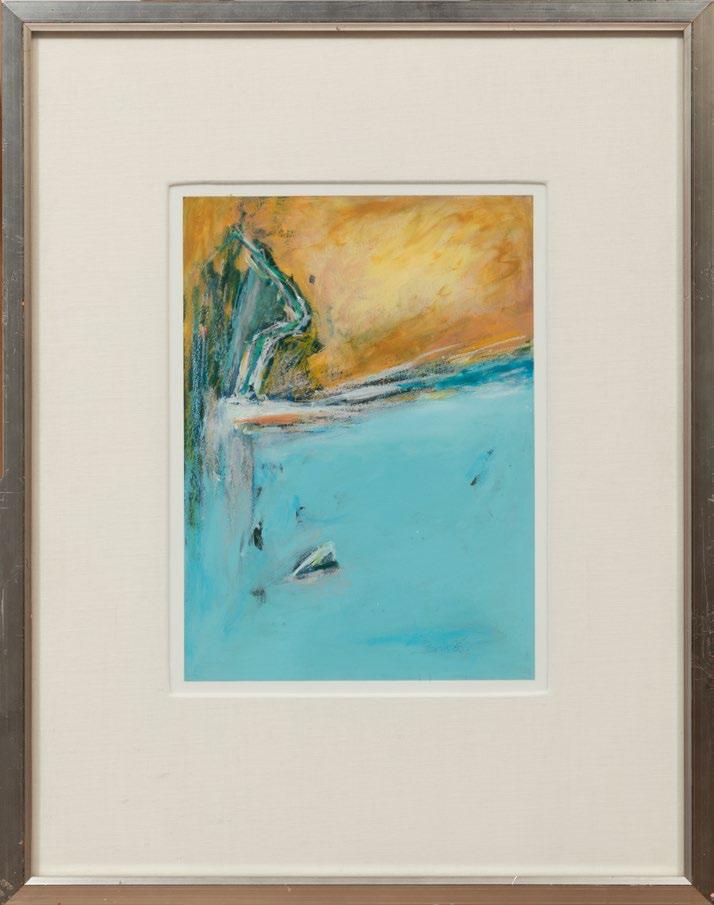
69. Nancy Harris (American/Louisiana, b. 1951), “Eye Care #4”, 1985, oil on paper, signed and dated lower right, signed, titled and dated upper center under mat, “Duplantier Gallery, New Orleans, LA” label on backing paper, 20 in. x 14 1/4 in., framed, overall 25 1/4 in. x 19 7/8 in . x 1 in. [$300/500]
70. Nancy Harris (American/Louisiana, b. 1951), “Golden Fields”, 2013, oil on canvas, signed and dated lower left, 40 in. x 30 in., framed, overall 41 1/2 in. x 31 1/2 in. x 1 3/4 in. [$1200/1800]


71. Peggy Hunter Port (American/Texas, 1943-2021), “Abstract Composition”, 2003, oil on gallery-wrapped canvas, signed twice and dated en verso, 30 in. x 24 in., unframed. [$800/1200]
Note: Peggy Port began her career as a sculptor in the late 1970s and now works primarily on canvas from her home in Houston where she is a well-known figure of the contemporary art scene. She graduated from Arkansas State University, received a graduate degree from the University of Texas, and completed additional studies at the Glassell School, Art League Houston, and West End Gallery in Santa Fe. Much of Port’s work consists of multiple layers of color and texture, often incorporating encaustic techniques. As noted by Virginia Billeaud Anderson of Greater Houston Weekly: “[Port] paints breathtaking abstractions constructed with Rothko like horizontal color tiers. Textural variation heightens their drama, ranging from thickly applied, mixed with sand or wax, to thinly painted passages.”
Ref.: Peggy Port Studios. www.peggyport.com. Accessed May 1, 2024.
72. Peggy Hunter Port (American/Texas, 1943-2021), “Abstract Composition”, 2005, oil and mixed media on gallerywrapped canvas, signed and dated en verso, 36 in. x 24 in., unframed. [$1000/1500]
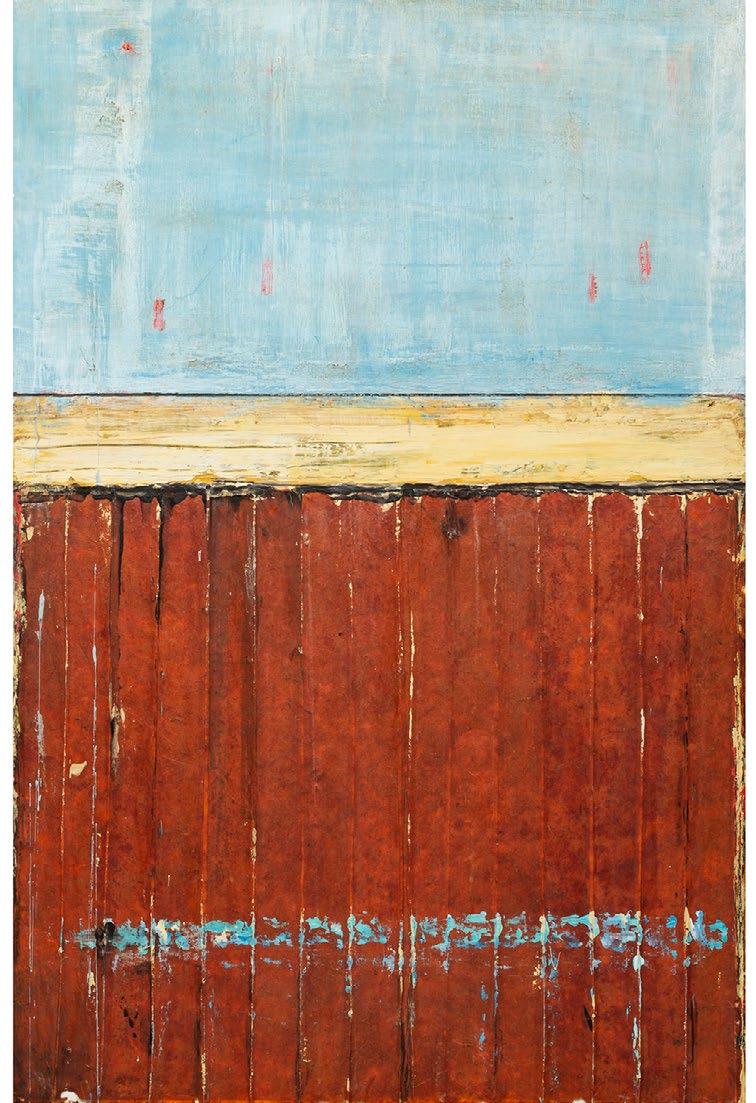


73. Caroline Wright (American/Texas, 20th c.), “The Unnecessary Sea, Variation”, 2008, acrylic and ink on paper, signed and dated lower right, titled lower left, 30 in. x 22 in., framed, overall 33 1/8 in. x 25 1/8 in. x 1 1/4 in.
[$700/1000]
Note: A native of Austin, Texas, Caroline Wright employs a multidisciplinary approach to painting that incorporates her love of music and dance in creating expressive abstract compositions. Following undergraduate studies at Brown University, Wright moved to Paris and lived in an abandoned state building in Belleville with artists from all over the world. Inspired by this experience to live a “life made through art,” she then returned to her hometown to participate in the city’s burgeoning art community. Wright later earned an MFA through the School of the Art institute of Chicago. Nature, rhythm, color and movement are at the heart of her works, many of which are now monumental in scale.
Ref.: “About.” Caroline Wright. www.carolinewrightart.com. Accessed Apr. 30, 2024.
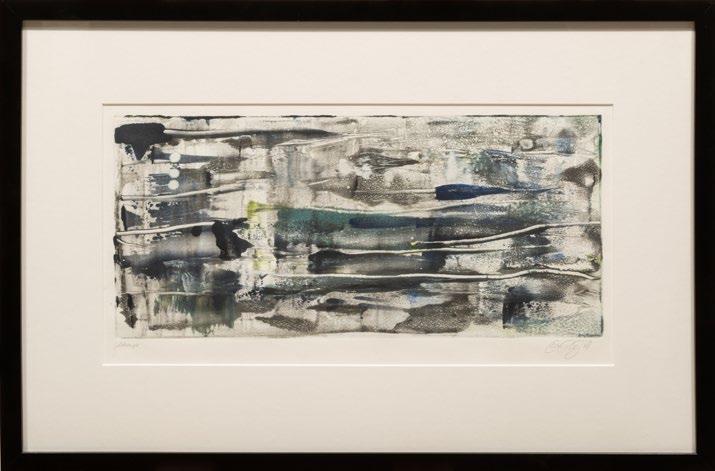

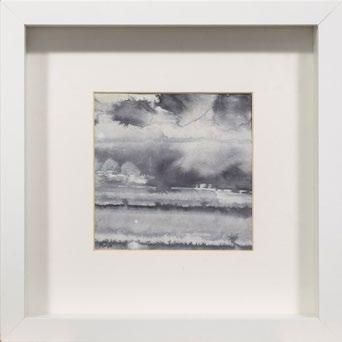
74. Caroline Wright (American/Texas, 20th c.), “The Wave of Last Year” and “Scherzo”, 2008, 2 monotypes, each signed and dated lower right, one titled lower left, one with “Bay 6, Austin TX” exhibition flyer and exhibition pricelist with artist, titles and dates on backing paper, 8 in. x 15 in. and 7 5/8 in. x 17 in., framed alike, overall 15 in. x 18 in. x 1 in. and 15 in. x 24 in. x 1 in.; and “Small Horizon”, 2010, ink on rice paper, initialed and dated lower left, 5 in. x 5 in., framed, overall 10 in. x 10 in. x 1 3/4 in. (3 pcs.)
[$600/800]
Exh.: “i do not know what it is i am like”, Bay 6 Gallery, Austin, TX, Mar. 7 - Mar. 22, 2009.
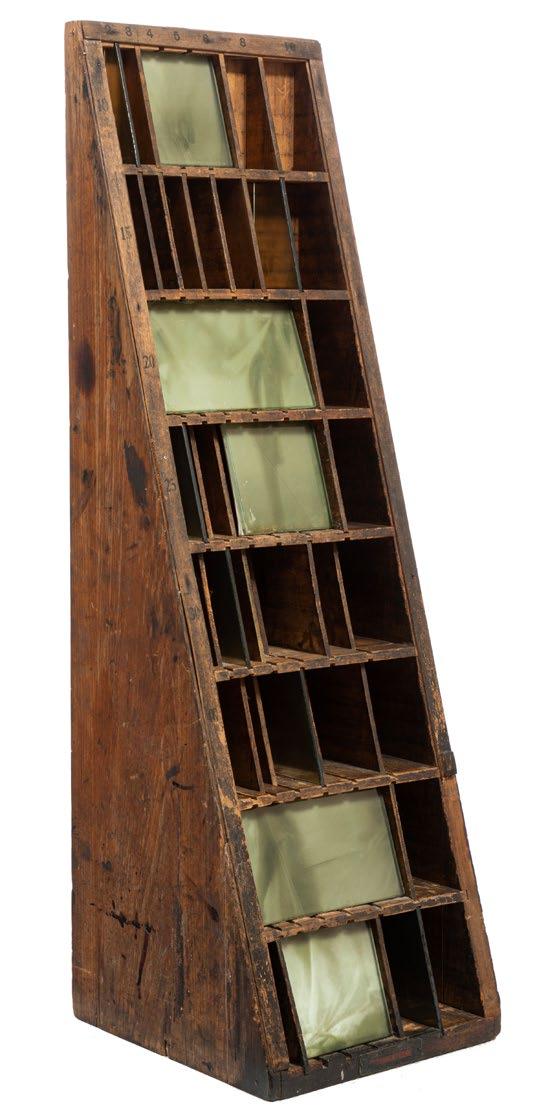
75. Michel Varisco (American/Louisiana, b. 1967), “Untitled”, found objects, wood, glass and mixed media, unsigned, h. 32 1/2 in., w. 9 3/4 in., d. 10 3/8 in., wood pedestal, overall h. 62 3/4 in. [$300/500]
Note: A native New Orleanian, Michel Varisco received her BA from Loyola University and MFA from Tulane University with additional studies in France and Italy. She is a multimedia artist with a focus on assemblage, photography, video, site specific installation and sculpture. Varisco’s work centers on “the human relationship to nature through architecture, engineered and wild environments.” She celebrates nature while also highlighting sustainable and unsustainable practices. Varisco has said of her art: “I analyze the interconnectedness of issues as they face Louisiana, the United States and other lands (and waters) around the world.” Her work is exhibited and published internationally and included in public, private and corporate collections worldwide. Varisco has been an honoree of the New Orleans Museum of Art for “Love in the Garden” and is a founder and former Vice President of the New Orleans Photo Alliance.
Ref.: “Bio / Artist Statement.” Michel Varisco. www.michelvarisco.com.
Accessed Apr. 30, 2024.
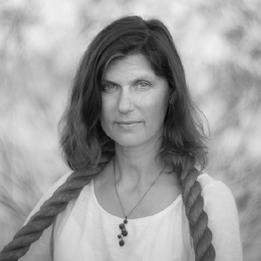
76. Chris Roberts-Antieau (American/Louisiana, b. 1950), “Lifted”, embroidered fabric appliques mounted to board, unsigned, 38 in. x 20 3/4 in., framed with artist and title plaque, overall 41 7/8 in. x 24 3/8 in. x 2 3/4 in. [$600/800]
Note: Chris Roberts-Antieau had her first connection with art in her seventh-grade home economics class, where she encountered sewing and formed a lifelong love of working with fabric. Despite a lack of encouragement, she forged a path to the fashion world, where she made hand appliq jackets and handbags for clients in New York City. Even though she was quite successful, the constraints of fulfilling orders and the manufacturing process ultimately proved too constricting to her creative side. She made the decision to put her work “under glass and not on bodies.” Roberts-Antieau utilizes a mixture of processes; fabric appliqué, thread painting and hand embroidery in a method she calls Fabric Painting, all done on a single Bernina sewing machine. This method is perfect for translating her unique and whimsical ideas into art, and her desire is to capture the “mysterious origins of joy.” In fact, that goal could be called her modus operandi: to find joy, experience it and spread it to others through art. Roberts-Antieau now owns galleries in Ann Arbor, Santa Fe and New Orleans and has works in museums and private collections all over the world - wonderful accomplishments for a woman with no formal art training who defied the odds and those who told her that she would never become an artist.

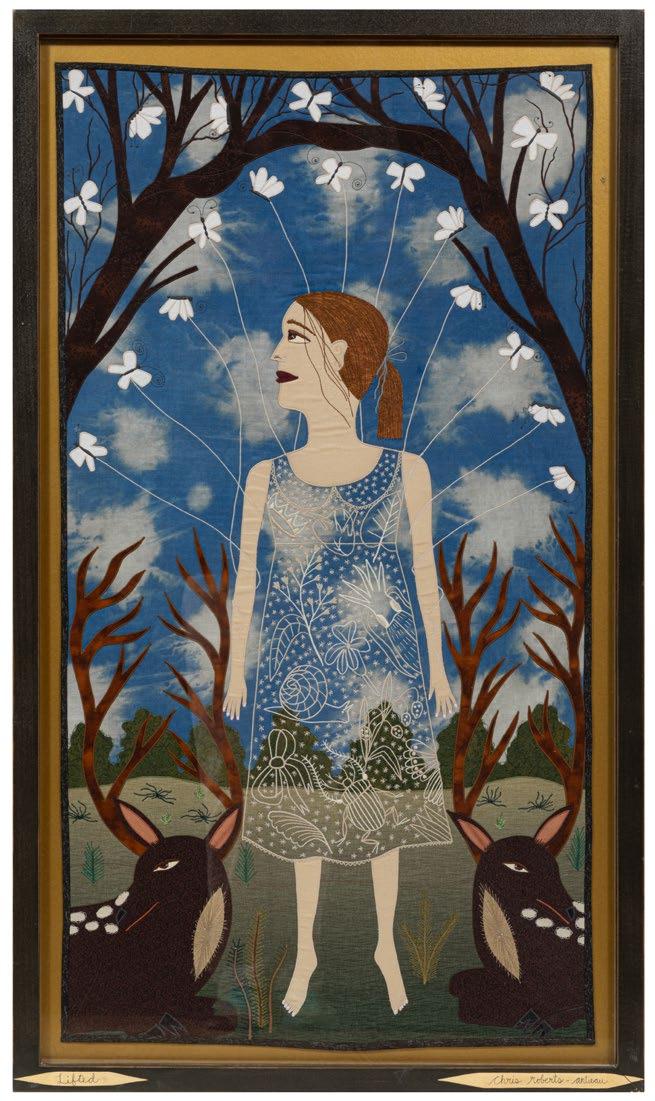
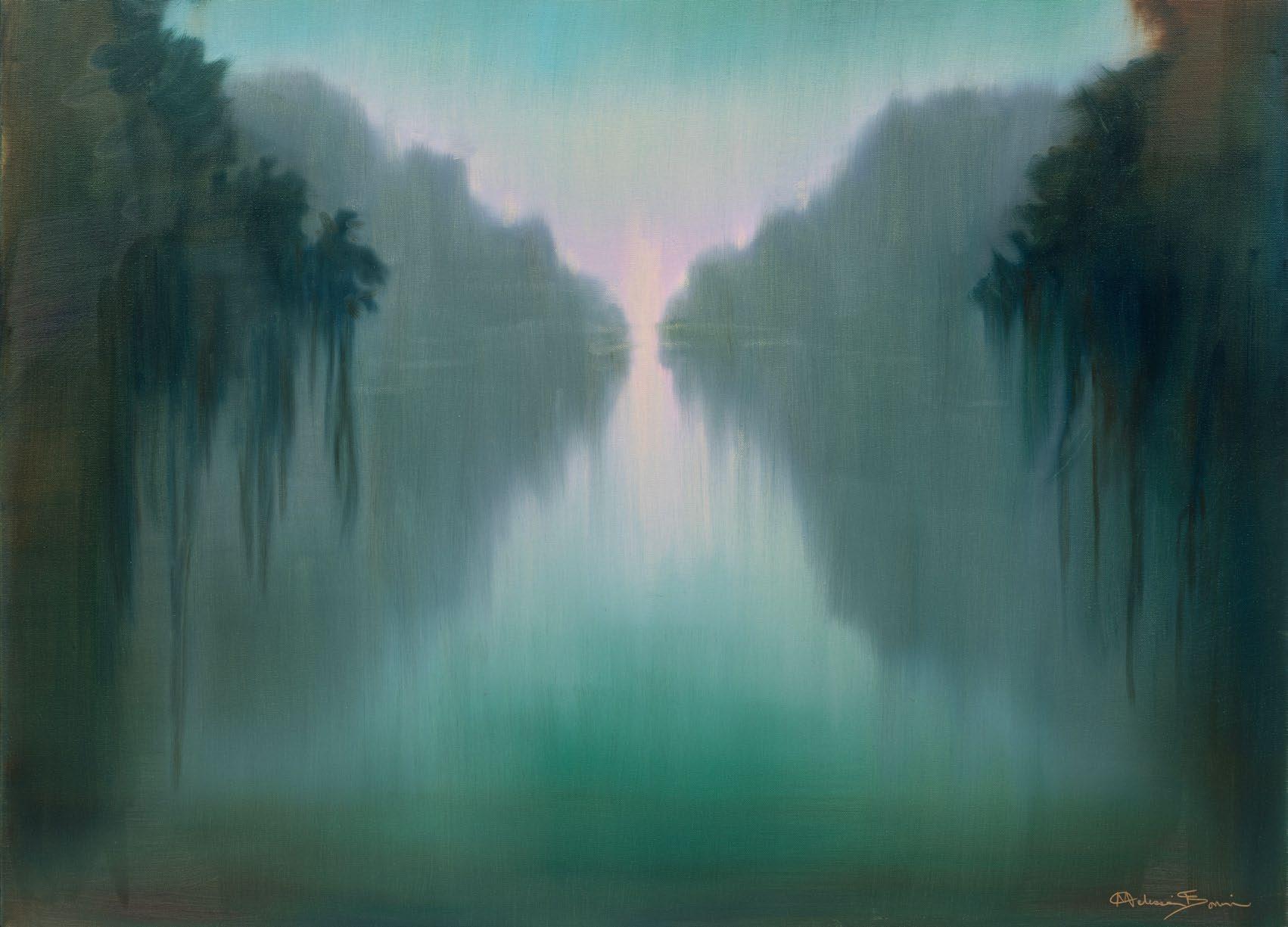
77. Melissa Bonin (American/Louisiana, b. 1960), “Mirror in the Sky”, 2022, oil on gallery-wrapped canvas, signed lower right, signed, dated and inscribed en verso, 30 in. x 40 in., unframed. [$4000/6000]
“When I go out on the water, something happens to me. I feel an electricity, an energy.”
- Melissa Bonin

Melissa Bonin
Note: New Iberia native Melissa Bonin started painting at the University of Louisiana in Lafayette at the age of fifteen at the insistence of local artist Elemore Morgan, Jr. who became her mentor and whose expressive landscapes inspired her in her subject matter and approach. At ULL, she also had the opportunity to study under Tom Secrest, Herman Mhire and William Moreland, all of whom she lists as influences for her body of work. After earning her BFA in 1981, she traveled abroad to study art and French in Paris, Angers and the south of France. She furthered her studies upon her return to the United States at Bennington College and the Massachusetts School of Fine Art in Boston. Bonin has achieved much recognition and many accolades for her work, receiving important commissions, such as a forty-eight-foot mural for the city of New Iberia, the Bunk Johnson award for Visual Arts, and an Atchafalaya Basin Foundation Grant. Her works are in many important private and public collections and have graced the walls of institutions such as the Ogden Museum of Southern Art, Knoxville Museum of Art, and the Bayou Teche Museum, among others.
Throughout her celebrated career, she has and continues to experiment with a multitude of media and is even a talented poet. Her paintings have evolved from her earlier abstract canvases featuring an experimental grid-like layout of colorful pastel squares to her more recent moody bayou landscapes.
A constant innovator who draws on her Cajun heritage as inspiration, Bonin has become an ambassador for Cajun culture and the state of Louisiana. With her adept brushstrokes, she is able to capture the timeless, luminous spirit of the bayou and its enduring beauty, symbolic of the resilience of the once violently displaced Cajun people. Her approach to creation is meditative, working in solitary silence and applying color to canvas instinctually and subconsciously. “Landscapes permit me to sit on the edge of abstraction and reality. You can manipulate colors in a way that produces a feeling of the landscape without copying everything realistically.”
Ref.: Kemp, John R. Expressions of Place: The Contemporary Louisiana Landscape. Jackson: University Press of Mississippi, 2016; Kemp, John R. “Melissa Bonin.” 64 Parishes. Sept. 12, 2012. www.64parishes.org. Accessed May 2, 2024.

78. Sibylle Peretti (German/Louisiana, b. 1964), “Untitled”, 2004, glass and mixed media polyptych, signed and dated lower right of fourth panel, “Gallery Soco, Austin, TX” label on backing paper, each panel 4 1/4 in. x 3 1/4 in., framed, overall 9 3/4 in. x 20 in. x 1 3/4 in. [$700/1000]
Provenance: Sylvia Schmidt Gallery, New Orleans, LA, 2004.
Note: Born in Germany, Sibylle Peretti now divides her time between Cologne, Germany and New Orleans. She earned an MFA in Sculpture and Painting from the Academy of Fine Arts in Cologne and a Master in Glass Making and Design from the State School of Glass in Zwiesel, Germany. Her work has earned grants from the Pollock-Krasner Foundation and the Joan Mitchell Foundation along with a United States Artist Fellowship in 2012. Her glass sculptures and multimedia collages which combine photography and drawing with engraving, mirroring and glass slumping often focus on themes of children and nature as symbols of innocence and promise.
Ref.: “Biography.” Sibylle Peretti. www.sibylleperetti.com. Accessed Apr. 30, 2024; “Sibylle Peretti.” Heller Gallery. www.hellergallery.com. Accessed Apr. 30, 2024.

79. Megan Kimber (American/Alabama, 20th c.), “Fisherman’s Daughter”, 2012, “Remember the Earth from which You Came”, These Forms, They Cannot Take Shape”, 2014, “Glass Carrier”, 2014, “Wing & Bone”, 2012 and “Oh, Thine with Four Legs and not Merely Two, Defend and Protect Us till the End”, 2014, 6 ink and mixed medias on board, 3 signed and dated lower right, 2 signed and dated lower left, one unsigned, each with label with artist, title and 3 with date on backing paper, dia. 4 1/2 in. to 13 in. x 10 1/2 in., each framed, overall dia. 6 3/4 in. x 1 in. to 15 3/4 in. x 13 3/8 in. x 1 in. (6 pcs.)
[$800/1200]
Provenance: grayDUCK Gallery, Austin, TX.
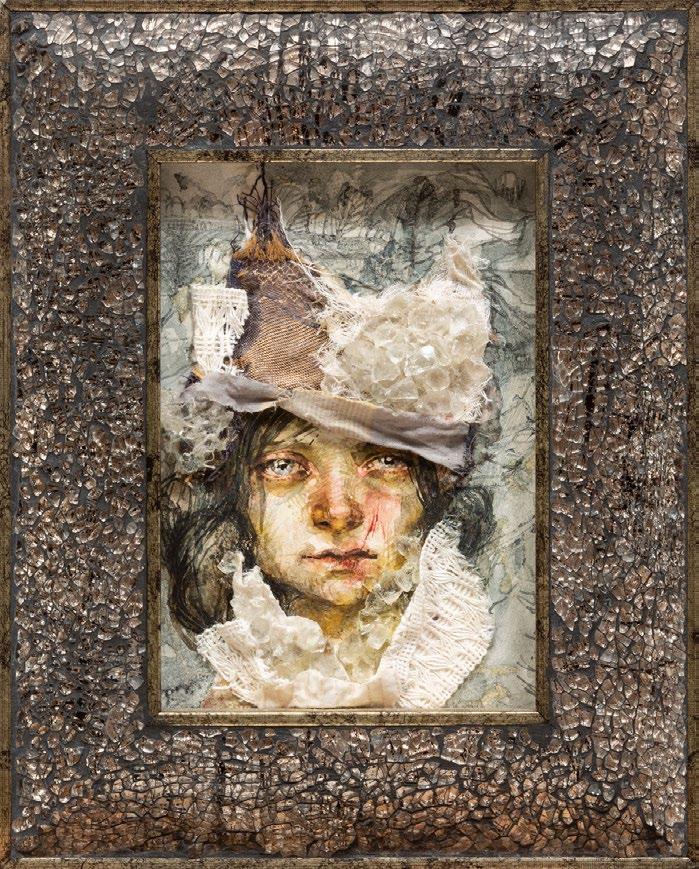
Note: Megan Kimber graduated from Rhode Island School of Design with a BFA in Illustration. After stints in Orlando and New York, she then moved to Savannah where she received her MFA in Illustration from the Savannah College of Art and Design. Kimber creates psychological portrait studies within environments reminiscent of the Brother’s Grimm fairy tales. She finds beauty in the unexpected with a color palette informed by the light at dusk. Her inspiration is drawn from nature, the woods of upstate New York where she spent her childhood and also her subjects themselves, as she has said: “The delicate strokes and strata are a glimpse into the internal world of the person I am painting – strong creatures they are, but they all have stories and they all have their cracks and fault lines and intricacies. I want my technique of painting to reflect that.”
Ref.: Campbell, Wendy. “Megan Kimber: Painting.” Daily Art Fixx. Mar. 9, 2013. www.dailyartfixx.com. Accessed May 1, 2024; Carmona, Kimberley. “Q&A with Art Night East Artist Megan Kimber.” Shuffle Online . Nov. 13, 2014. www.shuffleonline.net. Accessed May 1, 2024.
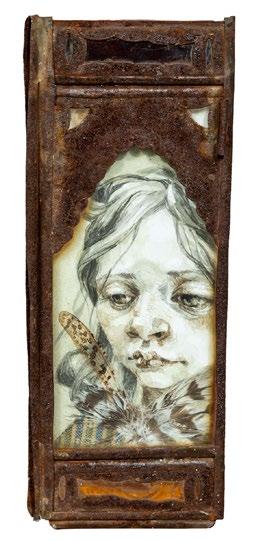




80. Nancy Guerrero (Chilean, b. 1976), “Smiley Face Bombs”, 2023, monotype “freestyle” silkscreen on panel, signed and dated en verso, 42 1/2 in. x 23 1/16 in., unframed. [$300/500]
Note: Nancy Guerrero is a Chilean artist living in France. She defines herself as a “character designer artist.” Guerrero’s work is influenced by vintage cartoons, kitsch and lowbrow art movements. She studied at the University of Chile and Heatherley School of Fine Art in London and developed a wide variety of techniques, such as sculpting, stone and wood carving, casting, pottery, printmaking, and digital imaging, that she has utilized to create her cutting-edge body of work.

81. Eye Sticker (American/New York, 21st c.), “Elmo”, 2023, acrylic on panel, signed, monogrammed, dated and artist sticker en verso, 7 7/8 in. x 7 15/16 in., unframed. [$200/300]
Note: Eye Sticker is a street artist based in New York City. She studied architecture at Shenkar College in Tel Aviv and practiced art her whole life, finally finding the time to focus on promoting her work during the 2020 pandemic. It all started with a sticker on the streets of the Village, whose subject matter of an eyeball was inspired by Picasso’s Guernica. Since then, she has worked on several large-format murals and continues to scatter her stickers throughout the city.
Ref.: Katz, Maddie. “Eye Sticker Has Seen It All.” UP: Street Art & Graffiti Magazine. www.upmag.com. Accessed May 2, 2024.



82. Kayla Mahaffey (American/Illinois, b. 1994), “Self Destruction”, 2022, polystone sculpture with acrylic visor, stamped signature, monogram, “THINKSPACE” and “PIPSTUDIO” on underside of self-base, edition of 200, published and fabricated in collaboration with Thinkspace Editions, Los Angeles and Pretty In Plastic, Hollywood, h. 13 in., w. 7 in., d. 7 in., original unopened box with embossed signature, monogram, publisher, fabricator and production date, contains signed and numbered certificate of authenticity. [$200/300]
Note: Born and raised on the South Side of Chicago, Kayla Mahaffey took the struggle in the world around her and the support from her community to evolve a unique and personal style that imbues her work with imagination, whimsy, positivity and the narrative of her own life story. Her works are best described as a mixture of pop art and Afro-surrealism and based around her childhood memories and the safety and comfort she felt in her younger years, particularly while watching cartoons. Mahaffey’s works have a depth of meaning and universal appeal that have led to her recent meteoric rise within the art world.
In the skilled hands of Mahaffey, popular culture imagery is re-purposed and re-invented. By combining immediately recognizable cartoon elements with images of Black children, she succeeds in carving out space for them, and herself, within the imaginative chaos. Her work is saturated in bubble gum and cotton candy colors and invites the viewer into the artist’s world, which is as sentimental and whimsical as it is deeply powerful.
Ref.: Scott, Chadd. “Kayla Mahaffey Explores Nostalgia in New Paintings.” See Great Art. Sept. 17, 2021. www.seegreatart.art. Accessed May 3, 2024; “Interview with Kayla Mahaffey for ‘Remember the Time.’” Sour Harvest. Sept. 21, 2021. www.sourharvest. com. Accessed May 3, 2024; Mahaffey, Kayla. “About.” Kayla May. www.kaylamay.art. Accessed May 3, 2024.



83. Madeline Donahue (American/Texas, b. 1983), “Angel Hair”, 2019, screenprint, pencil-signed lower right, numbered “87/193” lower left, printed by Kayrock Screenprinting, New York, sheet 24 in. x 18 in., framed, overall 27 1/16 in. x 21 1/16 in. x 7/8 in.
[$200/300]
Note: “I find all the difficulties of parenting pretty funny and a lot of my ideas come from feeling like I have totally failed or am totally humiliated by an experience.” -Madeline Donahue Brooklyn-based artist Madeline Donahue explores all aspects of motherhood in her charming and poignant depictions of the minutia of everyday parenting. In various media including color pencil, acrylic paints, ceramic and printmaking, she depicts the joy, heartache, difficulty, loneliness and absurdity of modernday motherhood.
Ref.: Hintz-Zambrano, Katie. “Artist & Mother Madeline Donahue.” Mother. Mar. 22, 2023. www.mothermag.com. Accessed May 3, 2023.
84. Madeline Donahue (American/Texas, b. 1983), “Slingshot”, 2021, risograph, pencil-signed, dated and numbered “50/100” lower margin, printed in collaboration with Elephant Magazine, London, sheet 15 1/4 in. x 11 3/4 in., framed, overall 18 1/4 in. x 14 7/8 in. x 7/8 in.
[$200/300]
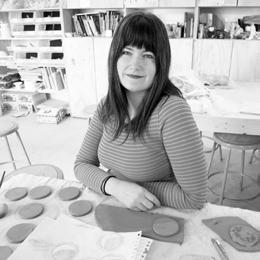


85. Madeline Donahue (American/Texas, b. 1983),
“Mother and Child”, 2022, acrylic on canvas, signed and dated en verso, 14 in. x 11 in., framed, overall 15 in. x 12 in. x 1 1/4 in.
[$1000/1500]
86. Madeline Donahue (American/Texas, b. 1983), “Mother and Child”, 2019, color pencil on paper, unsigned, 14 in. x 11 in., framed, overall 16 5/8 in. x 13 5/8 in. x 1 1/8 in.
[$300/500]


87. Sandra Russell Clark (American/Louisiana, b. 1949), “Isola Bella, Italy”, 1986/1987, 2 hand-colored gelatin silver prints from infrared film, each signed lower right, signed, titled and numbered en verso, from the Gardens of Reflection series, sheets 16 in. x 20 in. and 20 in. x 16 in., unframed. (2 pcs.)
[$1200/1800]
Note: A native of New Orleans, Sandra Russell Clark is a conceptual based photographer whose work explores the intimate relationship between memory and time. Over the last four decades, she has created images of New Orleans cemeteries, Gulf Coast landscapes, European and American gardens and architecture in Venice. Clark describes herself as a mostly self-taught photographer, although she did attend a class in 1978 with David Richmond, founder of the Photo Exchange Gallery, which inspired her passion for the medium. She served as the Director of Photography at the Contemporary Arts Center in New Orleans from 1980 to 1985 and continued her career as a fine art photographer, curator, teacher and author. Clark’s works have been exhibited and collected widely in the United States and abroad, earning her numerous awards, publications and accolades.
Ref.: Kemp, John R. “Sandra Russell Clark.” 64 Parishes. www.64parishes.org. Accessed May 2, 2024.
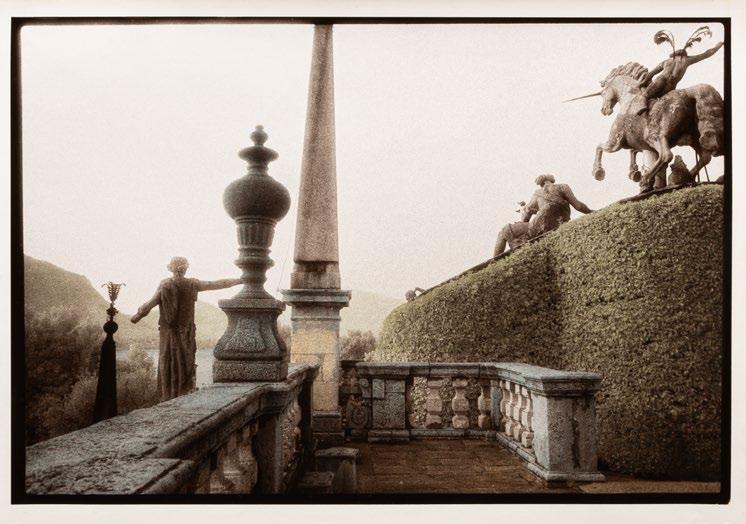

88. Sandra Russell Clark (American/Louisiana, b. 1949), “Isola Bella, Italy”, 1986/1987, 2 hand-colored gelatin silver prints from infrared film, each signed lower right, signed, titled and numbered en verso, from the Gardens of Reflection series, sheets 16 in. x 20 in., unframed. (2 pcs.)
[$1200/1800]
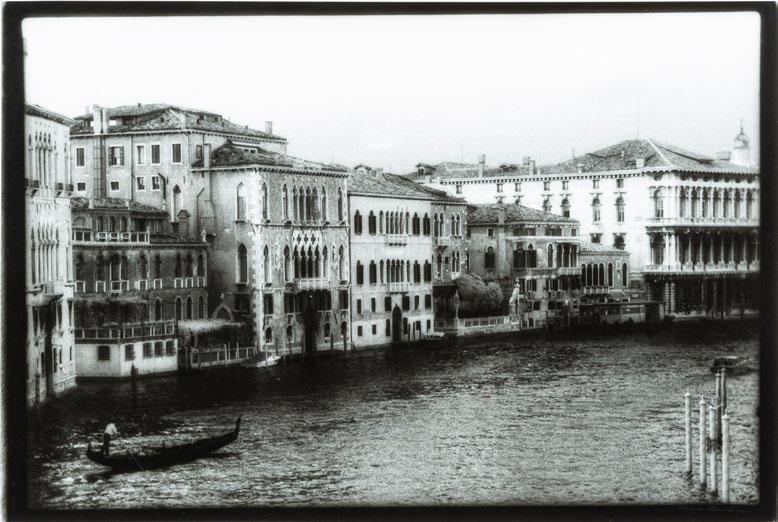

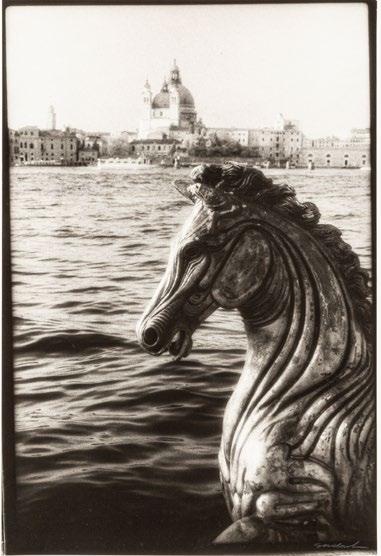
89. Sandra Russell Clark (American/Louisiana, b. 1949), “Venice, Italy”, 1992/1993, 3 gelatin silver prints from infrared film, each signed lower right, signed, titled and numbered en verso, from the Venice: A Vanishing Light series, sheets 16 in. x 20 in. to 20 in. x 16 in., unframed. (3 pcs.)
[$1200/1800]
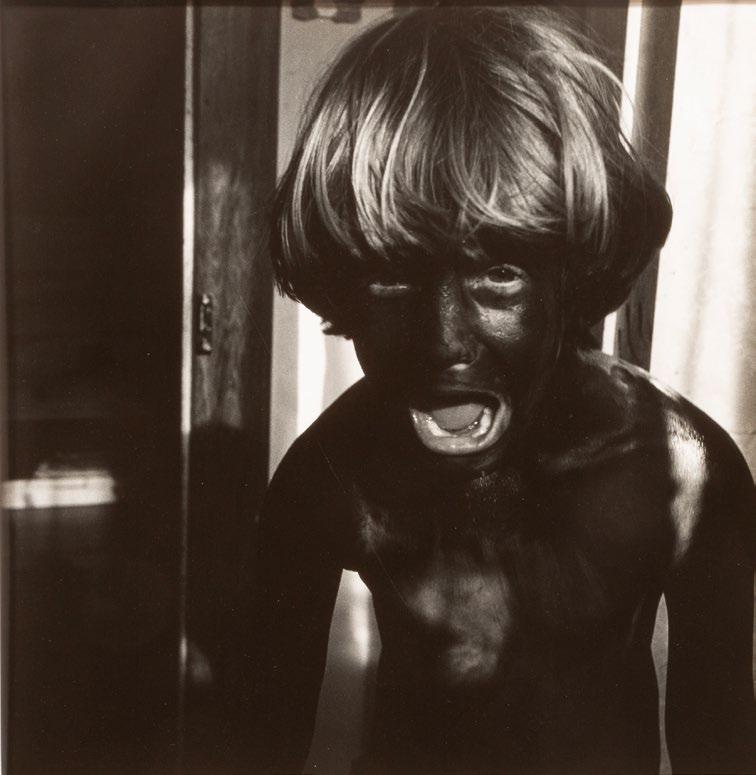
90. Debbie Fleming Caffery (American/Louisiana, b. 1948), “Untitled: Child Covered in Lipstick”, gelatin silver print, pencilsigned en verso, 23 3/4 in. x 20 in., matted, overall 28 in. x 26 in.
[$400/600]
Provenance: Arthur Roger Gallery, New Orleans, LA.
Note: The subject of a recent exhibition at the New Orleans Museum of Art, Debbie Fleming Caffery is considered one of the foremost photographers from the American South and undoubtedly is one of its most decorated and widely exhibited. Caffery grew up along the Bayou Teche in southwest Louisiana where she continues to reside today. Inspired by Dorothea Lange and many of the artists working with the Federal Arts Project of the WPA during the Depression, Caffery is interested in telling stories through her photographs in an approach that is as artful as it is documentary. Alongside her deep connection to the South, she has completed compelling bodies of work from Mexico, France and across the United States. Caffery explores the emotional relationships between people and places, just as her prints are the result of the deep relationships she builds with the people and places she captures with her camera. “Her photographs are not objective documents, but poetic stories that capture the mystery and spirit of the people and places she encounters.”
Ref.: “Debbie Fleming Caffery.” Octavia Art Gallery. www.octaviaartgallery.com. Accessed May 1, 2024; “Debbie Fleming Caffery: In Light of Everything.” New Orleans Museum of Art. www.noma.org. Accessed May 1, 2024.

91. Berenice Abbott (American, 1898-1991), “Tri-Boro Barber School, 264 Bowery, New York”, negative creation date 1935, print date 1979, gelatin silver print mounted on board, pencil-signed and numbered “22/60” on mount, from portfolio New York III, published by Parasol Press, New York, “Berenice Abbott’s New York” stamp with publisher information and print date on reverse of mount, 18 1/2 in. x 14 7/8 in., unframed.
[$2000/3000]
Note: Berenice Abbott was an iconoclastic photographer whose works and life transgressed the norms of the times. She studied sculpture in New York, Berlin and Paris, and she became a studio assistant to Man Ray who hired her because of her lack of experience with photography. In working with Man Ray, she discovered her love of the darkroom and began experimenting with a camera. She was a natural photographer with a keen eye.
Upon her return to the United States in 1929, she was struck by New York and its rapidly transforming landscape. “Old New York is fast disappearing,” she noted. Thus began a five-year project called “Changing New York,” in which Abbott documented the dynamism of the evershifting cityscapes around her.
In the 1930s, she began a relationship that would last about three decades with art historian and critic, Elizabeth McCausland. Together they lived in neighboring apartments in Greenwich Village and were described by friends as “homebodies with house cats.” After McCausland’s death in 1965, Abbott moved permanently to Maine and lived there until her own passing in 1991.
Ref.: Solomon, Deborah. “Berenice Abbott: She Was a Camera.” The New York Times. June 1, 2018. www.nytimes.com. Accessed May 6, 2024.
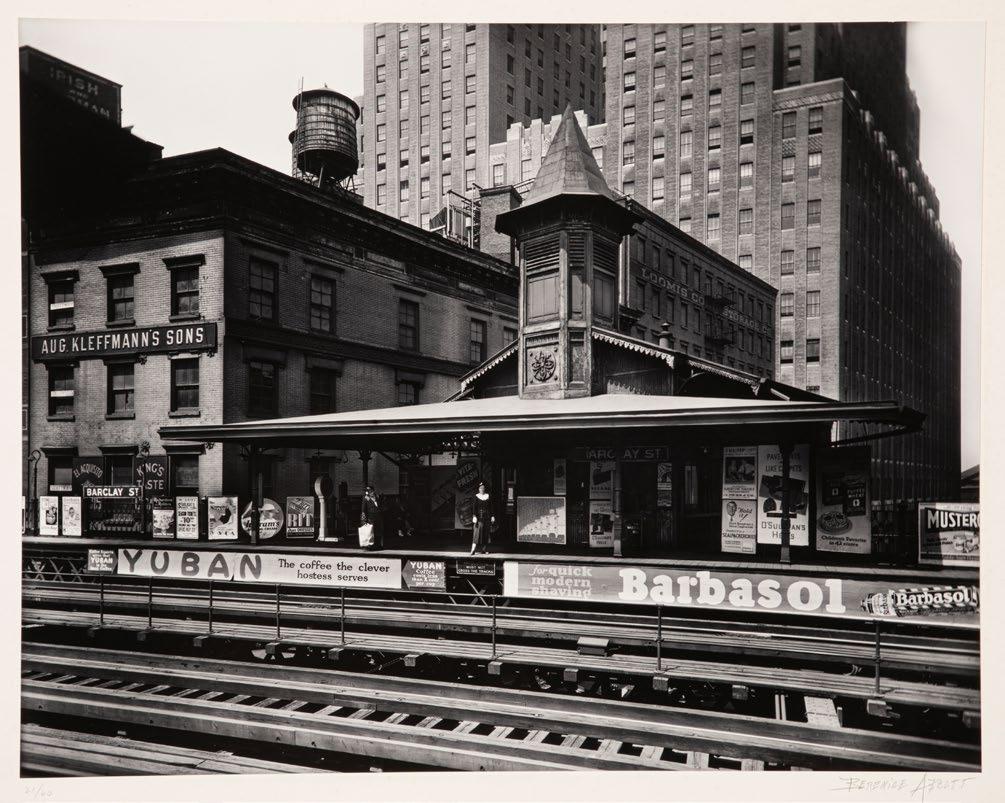
92. Berenice Abbott (American, 1898-1991), “Barclay Street Station, New York”, negative creation date 1932, print date 1979, gelatin silver print mounted on board, pencil-signed and numbered “21/60” on mount, published by Parasol Press, New York, “Berenice Abbott’s New York” stamp with publisher information and print date and “Christie’s 03 Oct 96 Sale 8482 lot 123” label on reverse of mount, 15 1/4 in. x 19 1/2 in., unframed.
[$2000/3000]
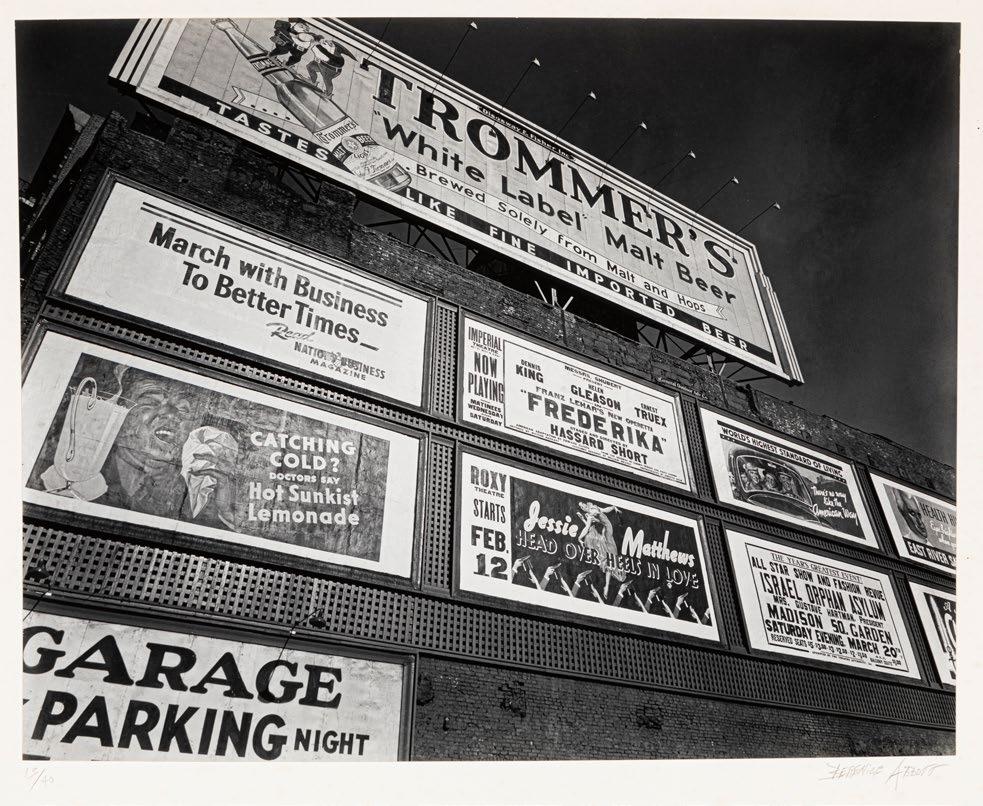
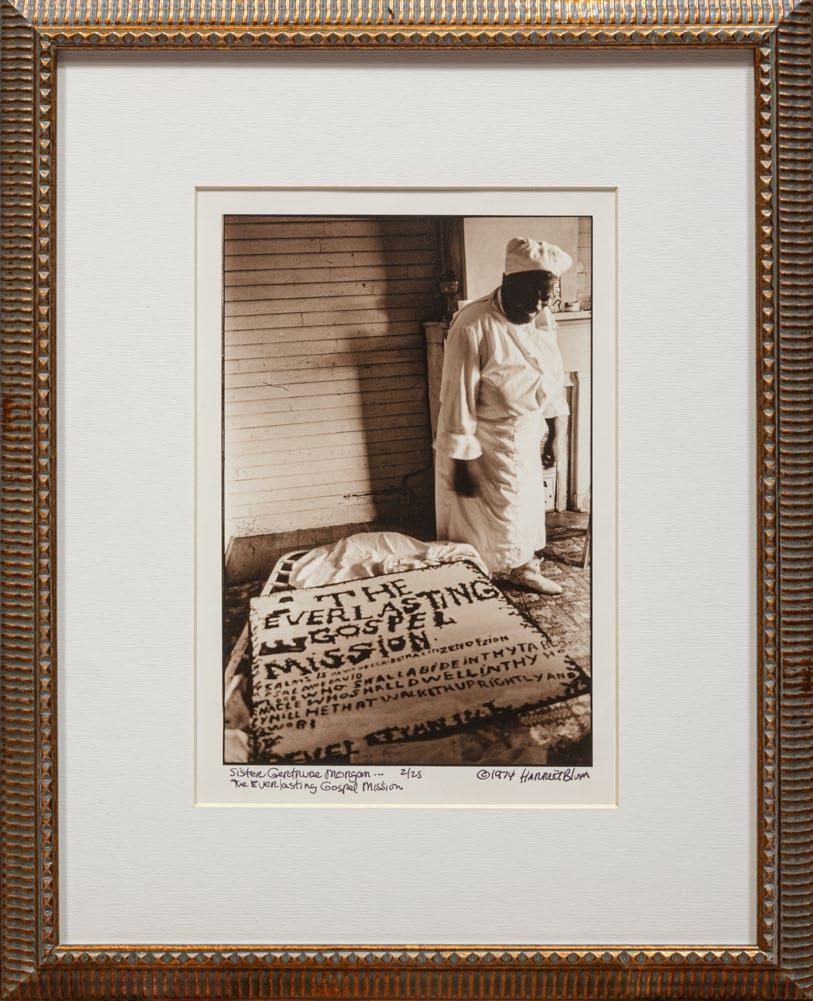
93. Berenice Abbott (American, 1898-1991), “Advertisements, East Houston Street and 2nd Ave.”, negative creation date 1937, print date 1982, gelatin silver print mounted on board, pencil-signed and numbered “13/40” on mount, published by Parasol Press, New York, “Berenice Abbott Retrospective” stamp with publisher information and print date on reverse of mount, 18 1/4 in. x 23 1/8 in., unframed. [$2000/3000]
94. Harriet Blum (American/Louisiana, b. 1949), “Sister Gertrude Morgan... The Everlasting Gospel Mission”, 1974, silver gelatin print, signed, titled, dated and numbered “2/25” lower margin, “Harriet Blum Collection LLC” label on backing paper, 8 1/2 in. x 5 3/4 in., framed, overall 15 3/4 in. x 11 5/8 in. x 3/4 in. [$400/600]
Note: Harriet Blum was born in 1949 in Miami, Florida and graduated from the University of Florida. Following her graduation, she relocated to New Orleans where her interest in photography was sparked. Starting with photojournalism, portrait and commercial photography, she shifted her focus to fine art photography by 2003. Her subjects now frequently include ethereal trees and landscapes. Her work is held in various private and public collections, including the Ogden Museum of Southern Art, New Orleans Museum of Art, Mobile Museum of Art, and the Field Museum of Natural History in Chicago. She is the winner of numerous awards, including “Best of Show” in the Bethesda Row Art Festival. Recently, and her iconic photo of Sister Gertrude Morgan at the 1973 New Orleans Jazz & Heritage Festival was featured in a Times Picayune article from April 22, 2024 in which Brian Piper describes: “Blum’s historic photograph — made in Jazz Fest’s infancy — is an emblematic reminder of the foundational importance of Black New Orleanians’ cultural expression to Jazz Fest’s success, both then and today. At the same time, Blum’s photograph evokes the unique combination of visual and aural sensations that make Jazz Fest such a dynamic experience.”
Ref.: “Artist Harriet Blum.” Where Y’art Works. www.whereyartworks.com. Accessed May 2, 2024; Piper, Brian. “A look back at Sister Gertrude Morgan, whose inspired paintings were seen at early Jazz Fests.” Times Picayune. Apr. 22, 2024. www.nola.com Accessed: May 7, 2024.

95. Harriet Blum (American/Louisiana, b. 1949), “Sister Gertrude Morgan, New Orleans Jazz and Heritage Festival”, 1974, silver gelatin print, pencil-signed, titled, dated and numbered “4/20” on mat, 12 in. x 7 3/4 in., framed, overall 21 1/2 in. x 17 1/2 in. x 1 1/8 in. [$600/800]
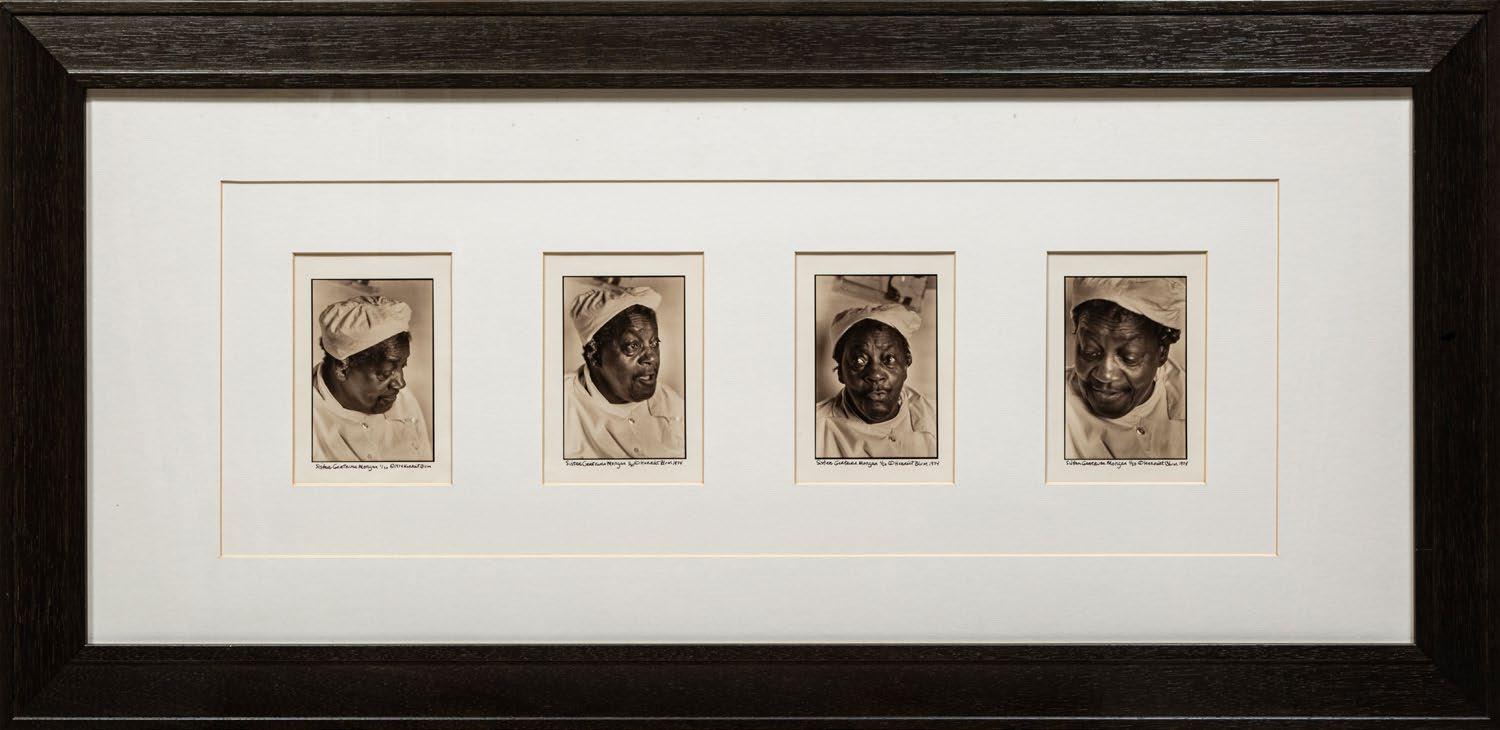
96. Harriet Blum (American/Louisiana, b. 1949), “Sister Gertrude Morgan”, 1974, 4 silver gelatin prints, each signed, titled, dated and numbered “1/50” lower margin, each 5 in. x 3 1/2 in., framed together, overall 20 1/2 in. x 41 7/8 in. x 3/4 in.
[$800/1200]
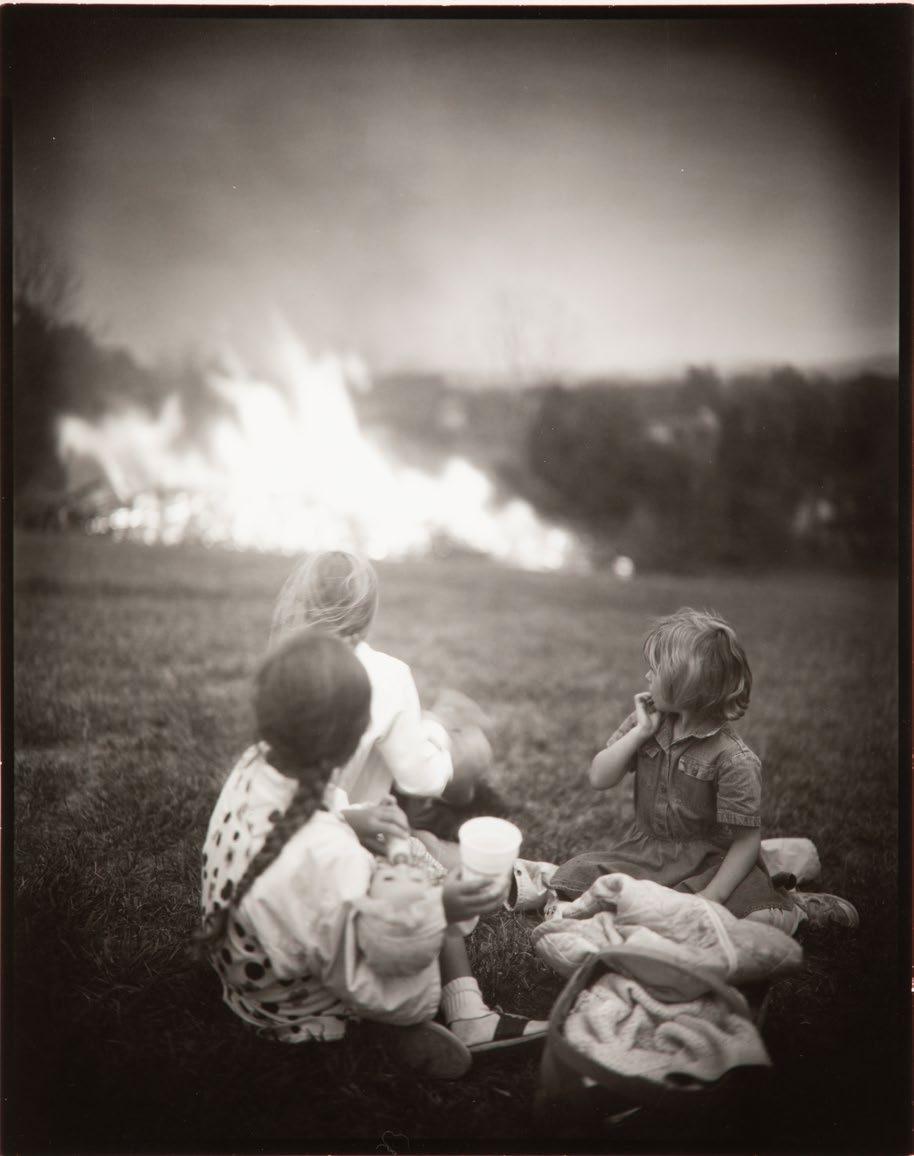
97. Sally Mann (American/Virginia, b. 1951), “Picnic”, 1992, gelatin silver print on non-archival paper, pencilinscribed letter to Jordan Patkin signed “S” en verso, 10 in. x 7 7/8 in., unframed. [$4000/6000]
Provenance: Gift from the artist to antique camera collector, Jordan Patkin; thence by descent.
Note: Sally Mann is one of the most renowned photographers in the world. Born in Lexington, Virginia in 1951, Mann began studying photography in the late 1960s through workshops in Yosemite National Park and at the Putney School and Bennington College, both in Vermont. She attended Hollins College in Roanoke, Virginia where she received her BA and MA. In contrast to her peers who were creating large-scale color photographic prints, Mann focused on nineteeth-century developing and printing techniques. In 2001, Time Magazine named Mann “America’s Best Photographer.” Mann lives in Virginia and is represented by Gagosian Gallery in New York City.
Jordan Patkin was a renowned antique camera collector. He loaned cameras to the Eastman Museum in Rochester, New York and also to Sally Mann herself who would mail him examples of the works she produced with his lenses with handwritten letters on the back such as in the lots offered here.
Ref.: “Sally Mann.” Gagosian. www.gagosian.com. Accessed May 2, 2024.

98. Sally Mann (American/Virginia, b. 1951), “Landscape”, gelatin silver print on non-archival paper, pencil-inscribed letter to Jordan Patkin signed “Sally” en verso, 7 7/8 in. x 9 7/8 in., unframed. [$3000/5000]
Provenance: Gift of the artist to antique camera collector, Jordan Patkin; thence by descent.
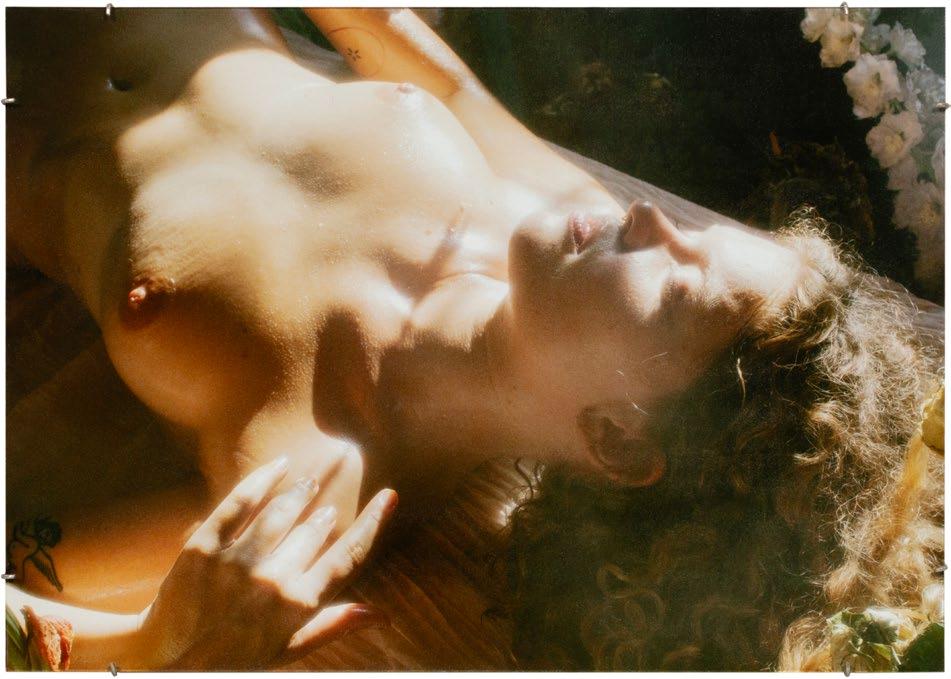
99. Mandy Torres (American/Louisiana, b. 1993), “Summer” and “Alex”, 2022, 2 archival Epson digital prints, each signed, titled and dated on backing board, 12 3/4 in. x 18 in. and 18 in. x 14 1/2 in., framed alike in gallery clip frames. (2 pcs.) [$300/500]
Note: Mandy Torres is an up-and-coming photographer garnering attention for her daring social practice and compositional formalism. Born in Memphis of Puerto Rican descent, she spent her childhood in the South and currently lives and works in New Orleans. Torres’ social practice – photoshoots in a party-like setting with professional photography equipment on the margins – both respects the city’s edge of exhibitionism and pushes its boundaries. She has shown her work at MOMA, Foam Fotografiemuseum Amsterdam, and inside a gas station in an abandoned naval base on the Mississippi River. Her photographs have been seen in Juxtapoz and in the French fashion magazine Purple

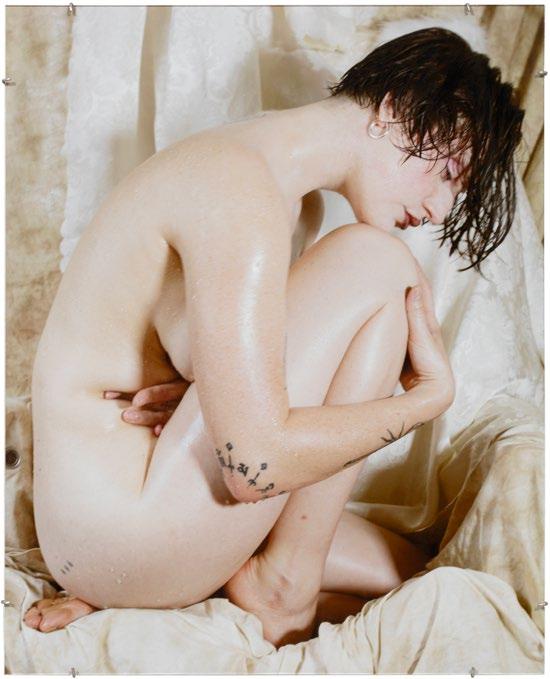
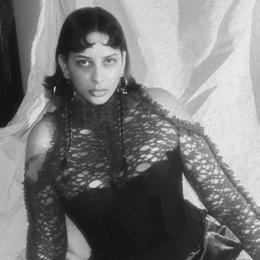
100. Chelsea Nyegaard (American/Louisiana, 21st c.), “Nude with Roses”, c-print on board, unsigned, 16 in. x 24 in., framed, overall 24 1/8 in. x 32 1/4 in. x 1 in.
[$100/200]
Note: Chelsea Nyegaard is a photographer from New Orleans, Louisiana. Shooting only on film, Nyegaard uses this analogue practice to bring out the authenticity of the moment being captured, as well as to connect to her grandfather who was a hobbyist photographer. Her work showcases the glitz, glam and debauchery for which Bourbon Street is known. She is currently represented by Mortal Machine Gallery in New Orleans.
Ref.: “Chelsea Nyegaard.” Mortal Machine Gallery. www.mortalmachinenola.com. Accessed May 2, 2024.

June 27 & 28 - Premier Collections Live Auction
July 18 - Mid-Century, Modern, Contemporary Art & Design
August 8 - UNRESERVED @ Neal Auction
September 19 & 20 - Premier Collections Live Auction
October 17 - UNRESERVED @ Neal Auction
November 14 & 15 - Louisiana Purchase Auction™
December 5 - UNRESERVED @ Neal Auction
December 19 - Mid-Century, Modern, Contemporary Art & Design Auction dates may be subject to change.



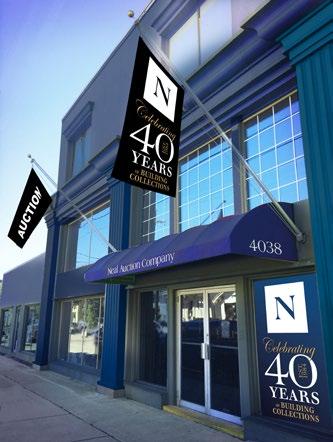


Neal Auction Company was founded June 7, 1984 by the late John R. Neal, noted collector and authority on 19th century American decorative arts.
From the beginning, Neal Auction Company has had a core focus on the history and material culture of the Lower Mississippi River Valley, which has led to our discovery of rare examples of furniture, paintings and decorative arts of the region, many of which are now in important institutional and private collections.
Our history includes legendary onsite auctions of important historic collections, notably the Sisters of Mercy Convent, Vicksburg, MS in 1984, and Houmas House Plantation, Darrow, LA in 2003, as well as block-buster sales of private collections such as the estate of author and tastemaker Julia Evans Reed in 2021.
Over the past forty years, we have enjoyed a frontrow seat to the ever-evolving market trends in taste and collecting, as we assist in dispersing estates and introducing the objects to new collections.
Today’s savvy collectors particularly respond to the eco-conscious aspect of recycling objects via auction. They recognize that they are seeking out unique objects with a history, not “cookie-cutter” mass-produced “disposable” goods.
As we enter our 5th decade, Neal Auction Company continues to be family-owned and locally managed, serving our New Orleans and regional community. We are proud to be one of Magazine Street’s landmark businesses, having debuted at 4139 Magazine then subsequently relocating to our 4038 Magazine address in 1990.
Berenice Abbott, 91-93
Yolande Ardissone, 60
Mary Nicol Neill Armour, 46
B
Julia Michel Black, 16
Harriet Blum, 94-96
Melissa Bonin, 77
Ruth Payne Burgess, 3
Debbie Fleming Caffery, 90
Sandra Russell Clark, 87-89
Charlotte Buell Coman, 5
D
Rise Delmar-Ochsner, 63-66
Eleanor Creekmore Dickinson, 56
Madeline Donahue, 83-86
Stella Drabkin, 27
Janice Anne Drevitson, 62
E
Mary Alexandra Bell Eastlake, 6
Eye Sticker, 81
F
Elizabeth Nelson Fairchild, 1
G
Dorothy Muriel Gillespie, 59
Jo Ann Greenberg, 55
Nancy Guerrero, 80
Theora Hamblett, 33
Lily Harmon, 15
Chestee Harrington, 42, 43
Nancy Harris, 68-70
Colette Pope Heldner, 24-26
Marie de Hoa LeBlanc, 11
Ruth Atkinson Holmes, 28
Marie Atkinson Hull, 29, 30
Clementine Hunter, 34-39
Sarah Joncas, 78
Megan Kimber, 79
Alberta Kinsey, 19-23
Ida Rittenberg Kohlmeyer, 57, 58
Kayla Mahaffey, 82
Sally Mann, 97, 98
Maude Mary Mason, 7
Hazel Guggenheim McKinley, 47
Geraldine Reed Millet, 12
Marie Madeleine Seebold Molinary, 10
Alice Moseley, 32
Chelsea Nyegaard, 100
Pauline Palmer, 9
Thelma Park, 44
Marcelle Martinet Peret, 18
Sibylle Peretti, 78
Peggy Hunter Port, 71, 72
Mary Louise Proctor, 41
Chris Roberts-Antieau, 76
Rhoda Brady Stokes, 31
Althea Dodson Tanner, 51
Terri Thomas, 67
Annie Tolliver, 40
Mandy Torres, 99
Sydney Stickland Tully, 2
Helen Maria Turner, 14
Michael Varisco, 75
Elizabeth O’Neill Verner, 13
Martha Walter, 45
Kay Walton, 61
Cora Kelley Ward, 52-54
Laura Wheeler Waring, 4
Marie Tebo Williamson, 17
Mabel May Woodward, 8
Caroline Wright, 73, 74
Jesselyn Benson Zurik, 48-50
John R. Neal (1940-2018), Founder
Michelle LeBlanc Leckert, CAI President
Katherine Hovas
Senior Vice President
Marc Fagan Vice President Consignments
ADMINISTRATION
Director of Administration & Finance
Michelle LeBlanc Leckert, CAI
Client Services / Accounts Receivables
Rebekah Abernathy
Database Management / Internet Auction Administrator
Lisa Weisdorffer
Bookkeeper
Katie Lasher
Marketing & Social Media
Cameron McHarg
General Manager
Jason Leckert
Administrative Assistant
Claire Whitmore
GRAPHICS
Graphics Director / Catalogue Design
David Roberts
Photography
Gerard Lewis
Jason Leckert
OPERATIONS
Operations Staff
Charlie Clay
Jerry Major
Graphics Staff
Stephanie Do Ouro
Amanda Torres
Paintings, Prints & Photography, Sculpture
Marney Robinson; Sophie Hirabayashi; Beth Sherwood; Casey Foote; Renee Longon
Books, Maps & Natural History Prints
Modern Furniture
Marc Fagan
Antique Furniture & Decorative Arts
Jason Leckert
Silver & Decorative Arts
Katherine Hovas
General Consignments, Jewelry & Couture
Cameron McHarg
Consignments Administrator
Heather Munch
Fine Art Inventory Manager. Wine & Spirits
Casey Foote
AUCTION SERVICES
Trust & Estates Advisor
Henry G. McCall
Appraisals
Marc Fagan, Cameron McHarg
CATALOGUE CONSULTANTS
Adam Trepagnier
Madison Randolph
Decorative Arts Inventory Management
Charlie Clay
AUCTIONEERS
Michelle LeBlanc Leckert #1514
Bettine Field Carroll #1874
Marc Fagan #1935
Marney Robinson #2155
Cameron McHarg #A-193
Asian Arts & Special Projects
Bettine Field Carroll
Silver
Carey Mackie
Decorative Arts & Victoriana
Ann M. Masson
GIA Graduate Gemologist
Stephen A. Moses